Go Math Solutions Resource is the best guide for students of 4th grade. In Go Math Grade 4 Answer Key Chapter 2 Multiply by 1-Digit Numbers you will find the questions and their detailed solutions in an easy manner. By using the 4th Standard Go Math solutions key everyone can prepare all chapter 2 topics easily & score well in the exams. This Go Math Grade 4 Answer Key Chapter 2 Multiply by 1-Digit Numbers will let students grasp the concepts properly & make them practice more regularly.
Go Math Grade 4 Answer Key Chapter 2 Multiply by 1-Digit Numbers
Practicing each and every step by step explained questions will provide immense results. Students can easily understand the topics of chapter 2 Multiply by 1-Digit Numbers via Go Math 4th Grade Answer Key. You will look up the concepts called Multiplication Comparisons, Multiplying using Distributive property and Expanded form, Estimate products, etc. clearly through this Go Math Grade 4 Answer Key Chapter 2 Multiply by 1-Digit Numbers for standard knowledge of the subject.
Lesson 1: Algebra • Multiplication Comparisons
- Common Core – Multiplication Comparisons – Page No. 67
- Common Core – Multiplication Comparisons – Lesson Check – Page No. 68
- Multiplication Comparisons – Page No. 71
Lesson 2: Algebra • Comparison Problems
- Common Core – Comparison Problems – Page No. 73
- Common Core – Comparison Problems – Lesson Check – Page No. 74
- Comparison Problems – Page No. 77
- Comparison Problems – Page No. 78
Lesson 3: Multiply Tens, Hundreds, and Thousands
- Common Core – Multiply Tens, Hundreds, and Thousands – Page No. 79
- Common Core – Multiply Tens, Hundreds, and Thousands – Lesson Check – Page No. 80
- Multiply Tens, Hundreds, and Thousands – Page No. 83
- Multiply Tens, Hundreds, and Thousands – Page No. 84
Lesson 4: Estimate Products
- Common Core – Estimate Products – Page No. 85
- Common Core – Estimate Products – Lesson Check – Page No. 86
- Estimate Products – Page No. 89
- Estimate Products – Page No. 90
Lesson 5: Investigate • Multiply Using the Distributive Property
- Common Core – Multiply Using the Distributive Property – Page No. 91
- Common Core – Multiply Using the Distributive Property – Lesson Check – Page No. 92
- Multiply Using the Distributive Property – Page No. 95
- Multiply Using the Distributive Property – Page No. 96
Lesson 6: Multiply Using Expanded Form
- Common Core – Multiply Using Expanded Form – Page No. 97
- Common Core – Multiply Using Expanded Form – Lesson Check – Page No. 98
- Multiply Using Expanded Form – Page No. 101
- Multiply Using Expanded Form – Page No. 102
Lesson 7: Multiply Using Partial Products
- Common Core – Multiply Using Partial Products – Page No. 103
- Common Core – Multiply Using Partial Products – Lesson Check – Page No. 104
- Multiply Using Partial Products – Page No. 105
- Multiply Using Partial Products – Page No. 106
- Multiply Using Partial Products – Page No. 109
- Multiply Using Partial Products – Page No. 110
Lesson 8: Multiply Using Mental Math
- Common Core – Multiply Using Mental Math – Page No. 111
- Common Core – Multiply Using Mental Math – Lesson Check – Page No. 112
- Multiply Using Mental Math – Page No. 115
- Multiply Using Mental Math – Page No. 116
Lesson 9: Problem Solving • Multistep Multiplication Problems
- Common Core – Problem Solving Multistep Multiplication Problems – Page No. 117
- Common Core – Problem Solving Multistep Multiplication Problems – Lesson Check – Page No. 118
- Problem Solving Multistep Multiplication Problems – Page No. 121
Lesson 10: Multiply 2-Digit Numbers with Regrouping
- Common Core – Multiply 2-Digit Numbers with Regrouping – Page No. 123
- Common Core – Multiply 2-Digit Numbers with Regrouping – Lesson Check – Page No. 124
- Multiply 2-Digit Numbers with Regrouping – Page No. 127
- Multiply 2-Digit Numbers with Regrouping – Page No. 128
Lesson 11: Multiply 3-Digit and 4-Digit Numbers with Regrouping
- Common Core – Multiply 3-Digit and 4-Digit Numbers with Regrouping – Page No. 129
- Common Core – Multiply 3-Digit and 4-Digit Numbers with Regrouping – Lesson Check – Page No. 130
Lesson 12: Algebra • Solve Multistep Problems Using Equations
- Multiply 3-Digit and 4-Digit Numbers with Regrouping – Page No. 133
- Multiply 3-Digit and 4-Digit Numbers with Regrouping – Page No. 134
- Common Core – Solve Multistep Problems Using Equations – Page No. 135
- Common Core – Solve Multistep Problems Using Equations – Lesson Check – Page No. 136
Chapter 2 Review/Test
- Review/Test – Page No. 137
- Review/Test – Page No. 138
- Review/Test – Page No. 139
- Review/Test – Page No. 140
- Review/Test – Page No. 141
- Review/Test – Page No. 142
- Page No. 147
- Page No. 148
Common Core – Multiplication Comparisons – Page No. 67
Write a comparison sentence.
Question 1.
6 × 3 = 18
6 times as many as 3 is 18.
Question 2.
63 = 7 × 9
Answer: 63 is 7 times as many as 9.
Explanation:

Question 3.
5 × 4 = 20
Answer: 5 times as many as 4 is 20.
Explanation:

Question 4.
48 = 8 × 6
Answer: 48 is 6 times as many as 8.
Explanation:

Write an equation.
Question 5.
2 times as many as 8 is 16.
Answer: 2 × 8 = 16
Explanation:

Question 6.
42 is 6 times as many as 7.
Answer: 42 = 6 × 7
Explanation:

Question 7.
3 times as many as 5 is 15.
Answer: 3 × 5 = 15
Explanation:

Question 8.
36 is 9 times as many as 4.
Answer: 36 = 9 × 4
Explanation:

Question 9.
72 is 8 times as many as 9.
Answer: 72 = 8 × 9
Explanation:

Question 10.
5 times as many as 6 is 30.
Answer: 5 × 6 = 30
Explanation:

Problem Solving
Question 11.
Alan is 14 years old. This is twice as old as his brother James is. How old is James?
Answer: 7 years old.
Explanation:
Alan’s age is 14 years old and his brother is James is twice younger than Alan, So James’s age is 14÷2= 7.
Question 12.
There are 27 campers. This is nine times as many as the number of counselors. How many counselors are there?
Answer: 3 counselors.
Explanation: 27 campers= 9× no.of counselors,
So no.of counselors are 27÷9= 3.
Question 13.
Draw a model, and write an equation to represent “4 times as many as 3 is 12.” Explain your work.
Answer: 4×3= 12.
Explanation:

Common Core – Multiplication Comparisons – Lesson Check – Page No. 68
Question 1.
Which equation best represents the comparison sentence?
24 is 4 times as many as 6.
Options:
a. 24 × 4 = 6
b. 24 = 4 × 6
c. 24 = 4 + 6
d. 4 + 6 = 24
Answer: b
Explanation:

Question 2.
Which comparison sentence best represents the equation?
5 × 9 = 45
Options:
a. 5 more than 9 is 45.
b. 9 is 5 times as many as 45.
c. 5 is 9 times as many as 45.
d. 45 is 5 times as many as 9.
Answer: d
Explanation:

Spiral Review
Question 3.
Which of the following statements correctly compares the numbers?
Options:
a. 273,915 > 274,951
b. 134,605 < 143,605
c. 529,058 > 530,037
d. 452,731 > 452,819
Answer: b
Explanation: 134,605 is lesser compared to 143,605.
Question 4.
What is the standard form for
200,000 + 80,000 + 700 + 6?
Options:
a. 2,876
b. 28,706
c. 208,706
d. 280,706
Answer: d
Explanation: 200,000+80,000+700+6= 280,706.
Question 5.
Sean and Leah are playing a computer game. Sean scored 72,491 points. Leah scored 19,326 points more than Sean. How many points did Leah score?
Options:
a. 53,615
b. 91,717
c. 91,815
d. 91,817
Answer: d
Explanation: Sean’s score is 72,491 and Leah’s score is 19,326 more than Sean’s score. So Sean score is 72,491+19,326 = 91,817.
Question 6.
A baseball stadium has 38,496 seats. Rounded to the nearest thousand, how many seats is this?
Options:
a. 38,000
b. 38,500
c. 39,000
d. 40,000
Answer: b
Explanation: Round off to nearest thousand is 38,000.
Multiplication Comparisons – Page No. 71
Question 1.
Maria’s dog weighs 6 times as much as her rabbit. Together the pets weigh 56 pounds. What does Maria’s dog weigh? Draw a model. Let n represent the unknown.

Answer: 48 Pounds.
Explanation: Let the weight of the rabbit be X and the dog’s weight is 6X. Both pet’s weight is 56 pounds i.e 6X+X=56, 7X=56 then X is 8.
Rabbit’s weight is 8 and Dog’s weight is 6×8= 48.
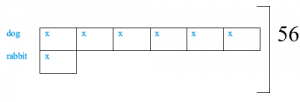
Draw a model. Write an equation and solve.
Question 2.
Last month Kim trained 3 times as many dogs as cats. If the total number of cats and dogs she trained last month is 28, how many cats did Kim train?
Answer: 7
Explanation: Let the cats trained to be X and dogs trained to be 3X.
Total Cats and Dogs she trained are 28, then X+3X= 28 and X= 7.
Therefore Cats trained are 7.
Question 3.
How many more dogs than cats did Kim train?
Answer: 21 dogs
Explanation: 3×7= 21.
Practice: Copy and Solve Draw a model.
Write an equation and solve.
Question 4.
At the dog show, there are 4 times as many boxers as spaniels. If there are a total of 30 dogs, how many dogs are spaniels?
Answer: 24.
Explanation: Let spaniels be S and the boxers be 4S. As the total is 30, S+4S=30 then 5S=30.
Therefore S is 6. Spaniels are 6 and boxers are 4 times as many as spaniels. So boxers are 4×6=24.
Question 5.
There are 5 times as many yellow labs as terriers in the dog park. If there are a total of 18 dogs, how many dogs are terriers?
Answer: 3.
Explanation: Let the Terriers be T and yellow labs be 5T. As total dogs are 18, 5T+T=18, and therefore T=18/6 which is 3. Terriers are 3.
Question 6.
Ben has 3 times as many guppies as goldfish. If he has a total of 20 fish, how many guppies does he have?
Answer: 15.
Explanation: Let Goldfish be X and Guppies be 3X, So X+3X= 20.
Therefore X= 5. So guppies are 3×5= 15.
Question 7.
Carlita saw 5 times as many robins as cardinals while bird watching. She saw a total of 24 birds. How many more robins did she see than cardinals?
Answer: 4 cardinals and 20 robins.
Explanation: Let the cardinals be X and robins be 5X. Then the total is 5X+X=24 then X= 4. So Carlita saw 4 cardinals and 5×4= 20 robins.
Multiplication Comparisons – Page No. 72
Question 8.
To get to a dog show, Mr. Luna first drives 7 miles west from his home and then 3 miles north. Next, he turns east and drives 11 miles. Finally, he turns north and drives 4 miles to the dog show. How far north of Mr. Luna’s home is the dog show? To solve the problem, Dara and Cliff drew diagrams. Which diagram is correct? Explain.
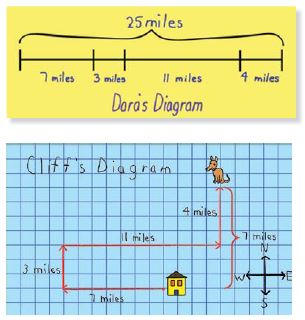
Answer: Cliff diagram is correct.
Explanation: Mr. Luna’s travels east and west are irrelevant to the question. As he drives 3 miles north, then he drives 4 more miles north. 3 + 4 = 7, so Mr. Luna ends up 7 miles north of his home.
Question 9.
Use Reasoning Valerie and Bret have a total of 24 dog show ribbons. Bret has twice as many ribbons as Valerie. How many ribbons does each have?
Valerie’s ribbons: ______ Bret’s ribbons: ______
Answer: Valerie has 8 and Bret has 16.
Explanation: Let the Valerie ribbons be X and Bret’s ribbons be 2X and the total be X+2X= 24. Therefore X= 8.
Valerie has 8 and Bret has 2×8= 16.
Question 10.
Noah built a fenced dog run that is 8 yards long and 6 yards wide. He placed posts at every corner and every yard along the length and width of the run. How many posts did he use?
Answer: 2×7+2×5+4(as he posted at every corner)= 14+10+4= 28 posts
Explanation: As there are 7 posts along one 8 yard side and 5 posts along one 6 yard side, so he used 2×7+2×5+4(as he posted at every corner)= 14+10+4= 28 posts
Question 11.
Last weekend, Mandy collected 4 times as many shells as Cameron. Together, they collected 40 shells. How many shells did Mandy collect? Complete the bar model. Then, write an equation and solve.

Common Core – Comparison Problems – Page No. 73
Draw a model. Write an equation and solve.
Question 1.
Stacey made a necklace using 4 times as many blue beads as red beads. She used a total of 40 beads. How many blue beads did Stacey use?
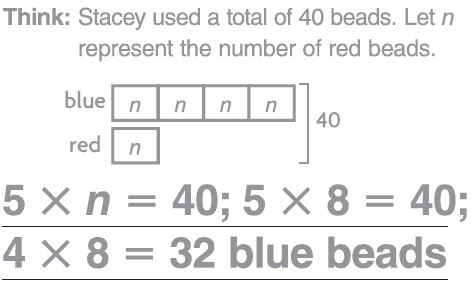
Question 2.
At the zoo, there were 3 times as many monkeys as lions. Tom counted a total of 24 monkeys and lions. How many monkeys were there?
______ monkeys
Answer: 18 monkeys.
Explanation:
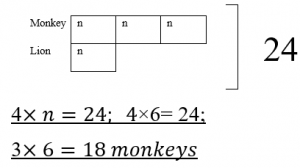
Question 3.
Fred’s frog jumped 7 times as far as Al’s frog. The two frogs jumped a total of 56 inches. How far did Fred’s frog jump?
Answer: 49 inches.
Explanation:
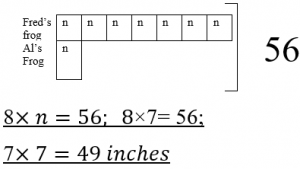
Question 4.
Sheila has 5 times as many markers as Dave. Together, they have 18 markers. How many markers does Sheila have?
Answer:
Explanation: 15 markers.
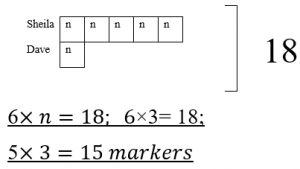
Problem Solving
Question 5.
Rafael counted a total of 40 white cars and yellow cars. There were 9 times as many white cars as yellow cars. How many white cars did Rafael count?
Answer: 36 white cars.
Explanation: Let yellow cars be X, As white cars are 9 times as many as yellow cars, So white cars be 9X. Therefore 9X+X=40, X=4. So no.of white cars are 9×4= 36.
Question 6.
Sue scored a total of 35 points in two games. She scored 6 times as many points in the second game as in the first. How many more points did she score in the second game?
Answer: 30 points.
Explanation: Let the first game points be X and second game points be 6X. Sue’s total score is 35 points in two games so 6X+X= 35 then X is 5. Therefore the second game score is 6×5= 30.
Question 7.
Write a problem involving how much more than and solve it. Explain how drawing a diagram helped you solve the problem.
Answer: Mike has 10 chocolates and John has 5 chocolates. How many more chocolates does Chirs have?
5 chocolates more Chirs have.
Explanation: As Mike has 10 chocolates and john has 5 chocolates, Chirs has 5 more chocolates than John.

Common Core – Comparison Problems – Lesson Check – Page No. 74
Question 1.
Sari has 3 times as many pencil erasers as Sam. Together, they have 28 erasers. How many erasers does Sari have?
Options:
a. 7
b. 14
c. 18
d. 21
Answer: d
Explanation: Let the X be pencil erasers of Sam and Sari erasers be 3X. As Sari and Sam together have 28 erasers. So 3X+X= 28. And X is 7. Then Sari has 3×7= 21.
Question 2.
In Sean’s fish tank, there are 6 times as many goldfish as guppies. There are a total of 21 fish in the tank. How many more goldfish are there than guppies?
Options:
a. 5
b. 12
c. 15
d. 18
Answer: d
Explanation: Let Guppies be X and Goldfishes be 6X. And the total fishes are 21, So X+6X= 21 then X= 3.
So Goldfishes are 6×3= 18.
Spiral Review
Question 3.
Barbara has 9 stuffed animals. Trish has 3 times as many stuffed animals as Barbara. How many stuffed animals does Trish have?
Options:
a. 3
b. 12
c. 24
d. 27
Answer: d
Explanation: Barbara has 9 stuffed animals and Trish has 3 times as Barbara, So 9×3= 27.
Question 4.
There are 104 students in the fourth grade at Allison’s school. One day, 15 fourth-graders were absent. How many fourth-graders were at school that day?
Options:
a. 89
b. 91
c. 99
d. 119
Answer: a
Explanation: Total students in fourth grade are 104, as 15 students were absent 104-15= 89.
Question 5.
Joshua has 112 rocks. Jose has 98 rocks. Albert has 107 rocks. What is the correct order of the boys from the least to the greatest number of rocks owned?
Options:
a. Jose, Albert, Joshua
b. Jose, Joshua, Albert
c. Albert, Jose, Joshua
d. Joshua, Albert, Jose
Answer: a
Explanation: As 98<107<112. So Jose, Albert, Joshua.
Question 6.
Alicia has 32 stickers. This is 4 times as many stickers as Benita has. How many stickers does Benita have?
Options:
a. 6
b. 8
c. 9
d. 28
Answer: 8.
Explanation: Let Benita stickers be S and Alicia has 32 stickers, So 4×S= 32. Therefore Benita stickers are 8.
Comparison Problems – Page No. 77
Question 1.
Use the drawing to find 2 × 500.

Answer: 2×= 1000.
Explanation: 2×500 is 2 times 5 hundreds, which is equal to 10 hundreds and 10 hundreds are equal to 1000.
Complete the pattern.
Question 2.
3 × 8 = 2
i. 3 × 80 = _____
ii. 3 × 800 = _____
iii. 3 × 8,000 = _____
Answer: 240, 2400, 24,000.
Explanation: 3×80= 240
3×800= 2400
3×8000= 24,000
Question 3.
6 × 2 = 12
i. 6 × 12 = _____
ii. 6 × 120 = _____
iii. 6 × 1,200 = _____
Answer: 72, 720, 7200.
Explanation: 6×12= 72
6×120= 720
6×1200= 7200.
Question 4.
i. 4 × 5 = _____
ii. 4 × 50 = _____
iii. 4 × 500 = _____
iv. 4 × 5,000 = _____
Answer: 20, 200, 2000, 20,000.
Explanation: 4×5= 20
4×50= 200
4×500= 2000
4×5,000= 20,000.
Find the product.
Question 5.
6 × 500 = 6 × _____ hundreds
= _____ hundreds
= _____
Answer: 6×5 hundreds = 30 hundreds.
Explanation: 6 × 500 = 6 × 5 hundreds = 30 hundreds = 3000
Question 6.
9 × 5,000 = 9 × _____ thousands
= _____ thousands
= _____
Answer: 9 × 5 thousands = 45 thousands.
Explanation: 9 × 5 thousands = 45 thousands. = 45,000.
Find the product.
Question 7.
7 × 6,000 = _____
Answer: 42,000.
Explanation:
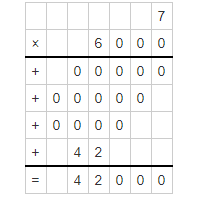
Question 8.
4 × 80 = _____
Answer: 320
Explanation:
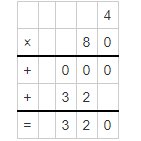
Question 9.
3 × 500 = _____
Answer: 1500
Explanation:
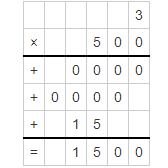
Use Reasoning Algebra Find the missing factor.
Question 10.
_____ × 9,000 = 63,000
Answer: 7
Explanation: As 7×9= 63
Question 11.
7 × _____ = 56,000
Answer: 8
Explanation: 7×8= 56.
Question 12.
8 × _____ = 3,200
Answer: 4
Explanation: 8×4= 32.
Question 13.
Communicate How does the number of zeros in the product of 8 and 5,000 compare to the number of zeros in the factors? Explain.
Answer: 8×5=40.
Explanation: There are 4 zeros in the product and 3 zeros only in the factors. Because there is a zero in basic fact as 8×5=40.
Comparison Problems – Page No. 78
Question 14.
Joe’s Fun and Sun rents beach chairs. The store rented 300 beach chairs each month in April and in May. The store rented 600 beach chairs each month from June through September. How many beach chairs did the store rent during the 6 months?
a. What do you need to know?
Answer: We need to know about the total number of beach chairs rented during the 6 months.
Question 14.
b. How will you find the number of beach chairs?
Answer: 300×2= 600 and 600×4= 2400. Total beach chairs are 3000
Explanation: We will multiply 2 times 300 and 4 times 600 and the will add the product.
Question 14.
c. Show the steps you use to solve the problem.
Answer: 300×2= 600 and 600×4= 2400. Total beach chairs are 3000.
Question 14.
d. Complete the sentences.
For April and May, a total of ______ beach chairs were rented.
Answer: 600
Explanation: As the store rented 300 beach chairs in April and May, So 300×2= 600.
Question 14.
For June through September, a total of _____ beach chairs were rented.
Answer: 2400
Explanation: As the store rented 600 beach chairs from June to September, So 600×4= 2400.
Question 14.
Joe’s Fun and Sun rented _____ beach chairs during the 6 months.
Answer: 3,000
Explanation: 300×2= 600 and 600×4= 2400. Total beach chairs are 3000.
Question 15.
Mariah makes bead necklaces. Beads are packaged in bags of 50 and bags of 200. Mariah bought 4 bags of 50 beads and 3 bags of 200 beads. How many beads did Mariah buy?
Answer: 800 beads.
Explanation: Mariah bought 4 bags of 50 beads which is 4×50= 200 beads. And 3 bags of 200 beads which is 3×200= 600. Total beads Mariah bought are 200+600= 800.
Question 16.
Carmen has three books of 20 stamps and five books of 10 stamps. How many stamps does Carmen have? Complete the equation using the numbers on the tiles.
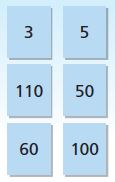
______ × 20 + ______ × 10 = ______
Answer: 3, 5, 110
Explanation: 3×20+5×10= 110.
Common Core – Multiply Tens, Hundreds, and Thousands – Page No. 79
Find the product.
Question 1.
4 × 7,000 = 28,000
Think: 4 × 7 = 28
So, 4 × 7,000 = 28,000
Question 2.
9 × 60 = _____
Answer: 540
Explanation: 9×6= 54.
Question 3.
8 × 200 = _____
Answer: 1600
Explanation: 8×2=16
Question 4.
5 × 6,000 = _____
Answer: 30,000.
Explanation: 5×6=30.
Question 5.
7 × 800 = _____
Answer: 5600
Explanation: 7×8= 56.
Question 6.
8 × 90 = _____
Answer: 720
Explanation: 8×9=72.
Question 7.
6 × 3,000 = _____
Answer: 18,000.
Explanation: 6×3= 18.
Question 8.
3 × 8,000 = _____
Answer: 24,000
Explanation: 3×8= 24.
Question 9.
5 × 500 = _____
Answer: 2500.
Explanation: 5×5= 25.
Question 10.
9 × 4,000 = _____
Answer: 36,000
Explanation: 9×4= 36.
Question 11.
7 × 7,000 = _____
Answer: 49,000.
Explanation: 7×7= 49.
Question 12.
3 × 40 = _____
Answer: 120.
Explanation: 3×4= 12.
Question 13.
4 × 5,000 = _____
Answer: 20,000.
Explanation: 4×5= 20.
Question 14.
2 × 9,000 = _____
Answer: 18,000
Explanation: 2×9= 18.
Problem Solving
Question 15.
A bank teller has 7 rolls of coins. Each roll has 40 coins. How many coins does the bank teller have?
Answer: 280 coins.
Explanation: Bank teller has 7 rolls of coins. As each roll has 40 coins, So total coins are 7×40= 280
Question 16.
Theo buys 5 packages of paper. There are 500 sheets of paper in each package. How many sheets of paper does Theo buy?
Answer: 2,500.
Explanation: Total no.of sheets of papers in each package are 500, And Theo buys 5 packages of papers. So total sheets of paper Theo bought are 500×5= 2,500.
Common Core – Multiply Tens, Hundreds, and Thousands – Lesson Check – Page No. 80
Question 1.
A plane is traveling at a speed of 400 miles per hour. How far will the plane travel in 5 hours?
Options:
a. 200 miles
b. 2,000 miles
c. 20,000 miles
d. 200,000 miles
Answer: b
Explanation: The speed of the plane is 400 miles per hour. In 5 hours plane can travel 400×5= 2,000 miles.
Question 2.
One week, a clothing factory made 2,000 shirts in each of 6 different colors. How many shirts did the factory make in all?
Options:
a. 2,000
b. 12,000
c. 120,000
d. 200,000
Answer: b
Explanation: Shirts made in one week are 2000 in 6 different colors. So total shirts made in all are 2000×6= 12,000.
Spiral Review
Question 3.
Which comparison sentence best represents the equation?
6 × 7 = 42
Options:
a. 7 is 6 times as many as 42.
b. 6 is 7 times as many as 42.
c. 42 is 6 times as many as 7.
d. 6 more than 7 is 42.
Answer: c
Explanation: By comparing 42= 6×7 represents the equation.
Question 4.
The population of Middleton is six thousand, fifty-four people. Which of the following shows this number written in standard form?
Options:
a. 654
b. 6,054
c. 6,504
d. 6,540
Answer: b
Explanation: Six thousand fifty-four is equal to 6,054.
Question 5.
In an election for mayor, 85,034 people voted for Carl Green and 67,952 people voted for Maria Lewis. By how many votes did Carl Green win the election?
Options:
a. 17,082
b. 17,182
c. 22,922
d. 152,986
Answer: a
Explanation: Total votes Carl Green has got are 85,034and Maria Lewis got are 67,952. By 85,034-67,952= 17,082 votes Carl Green won the election.
Question 6.
Meredith picked 4 times as many green peppers as red peppers. If she picked a total of 20 peppers, how many green peppers did she pick?
Options:
a. 4
b. 5
c. 16
d. 24
Answer: c
Explanation: Let the red peppers be X and green peppers be 4X, And the total she picked is 20 peppers. So X+4X=20,
Then X=4. Green peppers she picked are 4×4= 16.
Multiply Tens, Hundreds, and Thousands – Page No. 83
Question 1.
Estimate the product by rounding.
5 × 2,213
_____ × _____ = _____
Answer: 5×2000= 10,000
Explanation: The rounding off for 2,213 is 2000. So 5×2000= 10,000.
Question 2.
Estimate the product by finding two numbers the exact answer is between.
5 × 2,213
Answer: 5×2000= 10,000 and 5×3000= 15,000.
Explanation: The rounding off for 2,213 is 2000 and 3000. So 5×2000= 10,000 and 5×3000= 15,000.
Tell whether the exact answer is reasonable.
Question 3.
Kira needs to make color copies of a horse show flyer. The printer can make 24 copies in 1 minute. Kira says the printer makes 114 copies in 6 minutes.
Answer: Kira is incorrect.
Explanation: As the printer can make 24 copies in 1 minute, So if we take 24 rounds off to 20 or 30 then the printer makes 120 or 180 copies. So Kira is incorrect.
Question 4.
Jones Elementary is having a car wash to raise money for a community horse trail. Each car wash ticket costs $8. Tiara says the school will receive $1,000 if 125 tickets are sold.
Answer: Tiara says correct.
Explanation: As 1000÷125= 8 which is each car wash ticket cost. So the answer is reasonable.
Tell whether the exact answer is reasonable.
Question 5.
Evaluate Reasonableness Mrs. Hense sells a roll of coastal Bermuda horse hay for $58. She says she will make $174 if she sells 3 rolls.
Answer: The answer is reasonable.
Explanation: As 174 is the nearest rounding off to 180. So the answer is reasonable.
Question 6.
Mr. Brown sells horse supplies. A pair of riding gloves sells for $16. He says he will make $144 if he sells 9 pairs.
Answer: The answer is reasonable
Explanation: As 144 is between 90 and 180, So the answer is reasonable. Here we will take rounding off for 9 as 10 and 20. So the answer must be between 90 and 180.
Question 7.
Path A and Path B are walking paths used for horses. Path A is 118 feet long. Path B is 180 feet long. Carlos walks his horse down each path 3 times. Which path did Carlos use to walk his horse about 500 feet? Explain.
Answer: Path B
Explanation: 118 is rounded off to 100 and then multiply with 3, 100 Then round off 180 to 200 and multiply with 3, 200 As 500 is closer to estimate of 600 compared to 300. So Path B is correct.
Question 8.
Students in the third grade sell 265 tickets to the school play. Students in the fourth grade sell 3 times as many tickets as the third-grade students. Estimate the number of tickets the fourth-grade students sold by finding the two numbers the exact answer is between.
The students sold between

Answer: 600 and 900.
Explanation: 1let 265 be rounded off 200 and 300. As fourth-grade students sell 3 times as many as third-grade students, So 200 and 300 So tickets sold between 600 and 900.
Multiply Tens, Hundreds, and Thousands – Page No. 84
Predict whether the exact answer will be less than or greater than the estimate. Explain your answer.
Question 9.
The food stand at the zoo sold 2,514 pounds of hamburger last month. The average cost of a pound of hamburger is $2. Jeremy estimates that about $6,000 worth of hamburger was sold last month.
Answer: Lesser than the actual amount of hamburger.
Explanation: As the amount of hamburger sold is 468 pounds less than the estimated amount of 3000 pounds. So, the answer will be less than estimated.
Question 10.
A zoo bought 2,240 pounds of fresh food for the bears this month. The average cost of a pound of food is $4. Jeremy estimates that about $8,000 was spent on fresh food for the bears this month.
Answer: Greater than the actual amount of food bought.
Explanation: As the actual amount of food bought for the bears this month was 240 pounds greater than the estimated amount of 2,000 pounds. So, the answer will be greater than the estimated amount.
Common Core – Estimate Products – Page No. 85
Estimate the product by rounding.
Question 1.
4 × 472
4 × 472
↓
4 × 500 = 2,000
Question 2.
2 × 6,254
Answer: 12,000.
Explanation: The nearest rounding off for 6,254 is 6,000. So 2×6,000= 12,000.
Question 3.
9 × 54
Answer: 450
Explanation: The nearest rounding off for 54 is 50. So 9×50= 450.
Question 4.
5 × 5,503
Answer: 30,000.
Explanation: The nearest rounding off for 5,503 is 6,000. So 5×6,000= 30,000.
Question 5.
3 × 832
Answer: 2,400.
Explanation: The nearest rounding off for 832 is 800. So 3×800= 2,400.
Question 6.
6 × 98
Answer: The nearest rounding off for 98 is 100. So 6×100= 600.
Question 7.
8 × 3,250
Answer: The nearest rounding off for 3,250 is 3,000. So 8×3,000= 24,000.
Question 8.
7 × 777
Answer: 5,600.
Explanation: The nearest rounding off for 777 is 800. So 7×800= 5,600.
Find two numbers the exact answer is between.
Question 9.
3 × 567
Answer: 1500 and 1800.
Explanation: The rounding off for 567 is 500 and 600. So 3×500= 1500 and 3×600= 1800.
Question 10.
6 × 7,381
Answer: 42,000 and 48,000.
Explanation: The rounding off for 7,381 is 7,000 and 8,000. So 6×7000= 42,000 and 6×8000= 48,000.
Question 11.
4 × 94
Answer: 360 and 400.
Explanation: The rounding off for 94 is 90 and 100. So 4×90= 360 and 4×100= 400.
Question 12.
6 × 684
Answer: 3600 and 4200
Explanation: The rounding off for 684 is 600 and 700. So 6×600= 3600 and 6×700= 4200.
Problem Solving
Question 13.
Isaac drinks 8 glasses of water each day. He says he will drink 2,920 glasses of water in a year that has 365 days. Is the exact answer reasonable? Explain
Answer: Yes.
Explanation: As the round-off for 365 can be 300 or 400. So 8×300= 2,400 and 8×400= 3,200. The estimated answer can be between 2,400 to 3,200. So the answer is Yes.
Question 14.
Most Americans throw away about 1,365 pounds of trash each year. Is it reasonable to estimate that Americans throw away over 10,000 pounds of trash in 5 years? Explain.
Answer: No.
Explanation: As the round-off for 1,365 can be 1000 or 2000. So 5×1000= 5,000 and 5×2000= 10,000. The estimated answer can be between 5,000 to 10,000.
Common Core – Estimate Products – Lesson Check – Page No. 86
Question 1.
A theater has 4,650 seats. If the theater sells all the tickets for each of its 5 shows, about how many tickets will the theater sell in all?
Options:
a. 2,500
b. 10,000
c. 25,000
d. 30,000
Answer: c
Explanation: As the nearest round off for 4,650 is 5,000. So 5,000×5= 25,000.
Question 2.
Washington Elementary has 4,358 students. Jefferson High School has 3 times as many students as Washington Elementary. About how many students does Jefferson High School have?
Options:
a. 16,000
b. 12,000
c. 10,000
d. 1,200
Answer: b
Explanation: As the nearest round off for 4,358 is 4,000. So 4,000×3= 12,000.
Spiral Review
Question 3.
Diego has 4 times as many autographed baseballs as Melanie has. Diego has 24 autographed baseballs. How many autographed baseballs does Melanie have?
Options:
a. 28
b. 20
c. 8
d. 6
Answer: d
Explanation: Let the Melanie baseballs be S. As Diego has 4 times as many as Melanie and Diego has a total of 24 baseballs. So 4×S= 24, Then S= 24÷4 which is 6.
Question 4.
Mr. Turkowski bought 4 boxes of envelopes at the office supply store. Each box has 500 envelopes. How many envelopes did Mr. Turkowski buy?
Options:
a. 200
b. 504
c. 2,000
d. 20,000
Answer: c
Explanation: Turkowski has 4 boxes of envelopes and each box contains 500 envelopes, So total envelopes did Turkowski bought are 4×500= 2,000.
Question 5.
Pennsylvania has a land area of 44,816 square miles. Which of the following shows the land area of Pennsylvania rounded to the nearest hundred?
Options:
a. 44,000 square miles
b. 44,800 square miles
c. 44,900 square miles
d. 45,000 square miles
Answer: b.
Explanation: As the nearest round off for 44,816 is 44,800.
Question 6.
The table shows the types of DVDs customers rented from Sunshine Movie Rentals last year.

How many comedy and action movies were rented in all last year?
Options:
a. 13,620
b. 13,000
c. 12,260
d. 10,752
Answer: c
Explanation: Comedy and action movies that are rented in last year are 6,720+5,540= 12,260.
Estimate Products – Page No. 89
Model the product on the grid. Record the product.
Question 1.
3 × 13

3 × 13 = _____
Answer: 39
Explanation: 3×13= 3 ×(10+3)
=(3×10)+ (3×3)
=30+9
=39
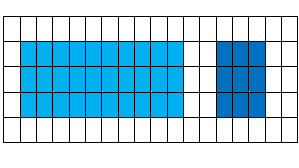
Question 2.
5 × 14

5 × 14 = _____
Answer: 70.
Explanation: 5×14 = 5×(10+4)
= (5×10)+(5×4)
= 50+20
= 70
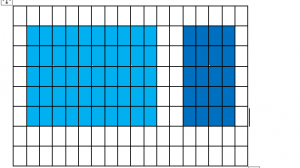
Find the product.
Question 3.
6 × 14

6 × 14 = ______
Answer: 84
Explanation: 6×14= 6×(10+4)
= (6×10)+(6×4)
= 60+24
= 84
Question 4.
5 × 18

5 × 18 = ______
Answer: 90
Explanation: 5 × 18 =5 ×(10+8)
= (5 × 10)+ (5 ×8)
= 50+40
= 90.
Question 5.
4 × 16

4 × 16 = ______
Answer: 64
Explanation: 4 × 16= (4 × 10)+( 4 ×6)
= 40+24
= 64.
Use grid paper or base-ten blocks to model the product.
Then record the product.
Question 6.
7 × 12 = ______
Answer: 84
Explanation: 7×12 = 7×(10+2)
=(7×10)+(7×2)
=70+14
84
Question 7.
5 × 16 = ______
Answer: 80
Explanation: 5×16= 5×(10+6)
=(5×10)+(5×6)
= 50+30
= 80
Question 8.
9 × 13 = ______
Answer: 117
Explanation: 9 × 13 = 9 ×(10+3)
=(9×10)+(9×3)
=90+27
=117
Question 9.
Explain how modeling partial products can be used to find the products of greater numbers.
Answer: 25 3= (20+5) 3
=(20×3)+(5×3)= 60+15=75
Explanation: The multiplication is easy. For example if we take 25 3= (20+5) 3
=(20×3)+(5×3)= 60+15=75
Question 10.
Use the Distributive Property to model the product on the grid. Record the product.
4 × 14 = _____
Answer: 56.
Explanation: 4×14= 4×(10+4)
=(4×10)+(4×4)
=40+16
=56
Estimate Products – Page No. 90
Question 11.
Kyle went to a fruit market. The market sells a wide variety of fruits and vegetables. The picture at the right shows a display of oranges. Write a problem that can be solved using the picture.
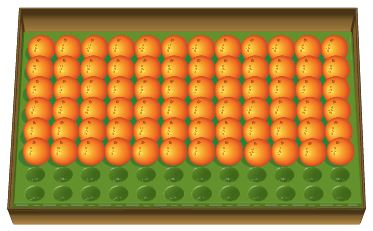
Answer: A shopkeeper has oranges. He keeps his oranges in the basket having 6 rows and each row has 12 oranges. So how many oranges he owned.
Explanation: From the above picture we can see 6 rows and 12 columns of Oranges. So total
no. of Oranges are 6 12= 72 Oranges.
Question 12.
Describe how you could change the problem by changing the number of rows of oranges and the number of empty spaces in the picture. Then solve the problem.
Common Core – Multiply Using the Distributive Property – Page No. 91
Model the product on the grid. Record the product.
Question 1.
4 × 19 = 76

4 × 10 = 40 and 4 × 9 = 36
40 + 36 = 76
Question 2.
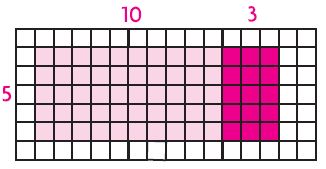
5 × 13 = ______
Answer: 65.
Explanation:
5×10= 50 and 5×3= 15
50+15= 65.
Find the product.
Question 3.
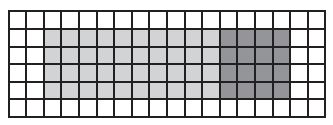
4 × 14 = ______
Answer: 56
Explanation:
4×10= 40 and 4×4= 16
40+16= 56.
Question 4.

3 × 17 = ______
Answer: 51
Explanation:
3×10=30 and 3×7= 21
30+21= 51
Question 5.

6 × 15 = ______
Answer: 90
Explanation:
6×10= 60 and 6×5= 30
60+30= 90
Problem Solving
Question 6.
Michael arranged his pennies in the following display.
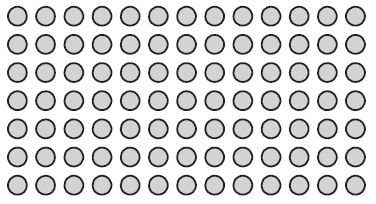
How many pennies does Michael have in all?
Answer: 91
Explanation: As there are 7 columns and 13 rows, So 13×7= 91.
Question 7.
A farmer has an apple orchard with the trees arranged as shown below.
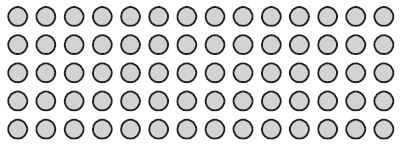
If the farmer wants to pick one apple from each tree, how many apples will he pick?
Answer: 70
Explanation: As there are 5 columns and 14 rows, So 5×14= 70.
Common Core – Multiply Using the Distributive Property – Lesson Check – Page No. 92
Question 1.
The model shows how Maya planted flowers in her garden.

How many flowers did Maya plant?
Options:
a. 15
b. 18
c. 30
d. 45
Answer: d
Explanation: As 3×10= 30 and 3×5= 15
30+15= 45.
Question 2.
The model below represents the expression 5 x 18.
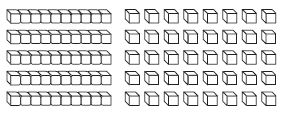
How many tens will there be in the final product?
Options:
a. 5
b. 6
c. 8
d. 9
Answer: d
Explanation: As 5×18 is 90 and 90÷10= 9. So answer is 9.
Spiral Review
Question 3.
Center City has a population of twenty one thousand, seventy people. Which of the following shows the population written in standard form?
Options:
a. 21,007
b. 21,070
c. 21,077
d. 21,700
Answer: b
Explanation: Twenty-one thousand seventy is equal to 21,070.
Question 4.
Central School collected 12,516 pounds of newspaper to recycle. Eastland School collected 12,615 pounds of newspapers. How many more pounds of newspaper
did Eastland School collect than Central School?
Options:
a. 99 pounds
b. 101 pounds
c. 199 pounds
d. 1,099 pounds
Answer: a
Explanation: Central school has collected 12,516 pounds and Eastland school collected 12,615 pounds. So
12,615-12,516= 99.
Question 5.
Allison has 5 times as many baseball cards as football cards. In all, she has 120 baseball and football cards. How many baseball cards does Allison have?
Options:
a. 20
b. 24
c. 96
d. 100
Answer: d
Explanation: Let Football cards be X and baseball cards be 5X. So 5X+X= 120 in which X= 20. As Allison has 5 times as many baseball cards as football cards. So 5×20= 100.
Question 6.
A ruby-throated hummingbird beats its wings about 53 times each second. About how many times does a ruby throated hummingbird beat its wings in 5 seconds?
Options:
a. 25
b. 58
c. 250
d. 300
Answer: c
Explanation: As the nearest round-off for 53 is 50, So 50×5= 250.
Multiply Using the Distributive Property – Page No. 95
Question 1.
Find 4 × 213. Use expanded form.

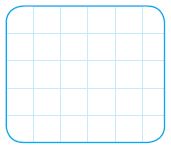
_____
Record the product. Use expanded form to help.
Question 2.
4 × 59 = _____
Answer: 236
Explanation: 4×(50+9)
= (4×50)+(4×9)
= 200+36
= 236.
Question 3.
3 × 288 = _____
Answer: 864
Explanation: 3×(200+80+8)
= (3×200)+(3×80)+(3×8)
= 600+240+24
= 864.
Record the product. Use expanded form to help.
Question 4.
4 × 21 = _____
Answer: 84
Explanation: 4×(20+1)
= (4×20)+(4×1)
= 80+4
= 84.
Question 5.
6 × 35 = _____
Answer: 210
Explanation: 6×(30+5)
= (6×30)+(6×5)
= 180+30
= 210.
Question 6.
A hotel has 128 rooms on each floor. There are 4 floors in all. If 334 of the rooms in the hotel have been cleaned, how many rooms still need to be cleaned?
Answer: 178.
Explanation: Total floors in a hotel are 4 and each floor has 128 rooms, So total rooms in the hotel are 128×4= 512.
In 512 rooms 334 were cleaned and the remaining rooms yet to be cleaned are 512-334= 178.
Question 7.
Ben wants to buy 2 blue sweaters for $119 each and 3 brown sweaters for $44 each. How much will Ben spend on the five sweaters?
Answer: $370.
Explanation: Ben wants to buy 2 blue sweaters for $119 each, So 119×2= 238. And 3 brown sweater for $44 each which means 44×3= 132. The total he spent on five sweaters is 238+132= 370.
Question 8.
A jeweler has 36 inches of silver chain. She needs 5 times that much to make some necklaces and 3 times that amount to make some bracelets. How much silver chain does the jeweler need to make her necklaces and bracelets?
Answer: 288 inches.
Explanation: As the jeweler has 36 inches of silver chain and she needs 5 times to make some necklaces which means 36×5= 180 and 3 times to make a bracelet which means 36×3= 108. So the total sliver she needs is 180+108= 288.
Question 9.
Gretchen walks her dog 3 times a day. Each time she walks the dog, she walks 1,760 yards. How many yards does she walk her dog in 3 days?
Answer: 15,840 yards.
Explanation: Gretchen walks 3 times a day which means for 3 days it will be 9 times. As she walks 1,760 yards, So 1760×9= 15,840.
Question 10.
Write an Expression Which expression could you write to show how to multiply 9 × 856 using place value and expanded form?
Answer: (9×800)+(9×50)+(9×6)
Explanation: Place value is the value of each digit in a number. So 856 can be expanded as 800+50+6.
Question 11.
Jennifer bought 4 packages of tacks. There are 48 tacks in a package. She used 160 of the tacks to put up posters. How many tacks does she have left? Explain.
Answer: 32.
Explanation: Jennifer bought 4 packages of tacks and each package contains 48 tacks. So total tacks are 48×4= 192.
As she used 160 tacks total tacks she left are 192-160= 32
Multiply Using the Distributive Property – Page No. 96
Use the table for 12–13.
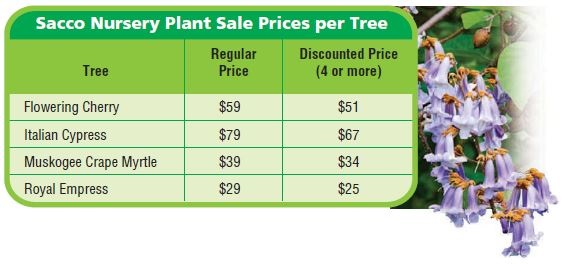
Question 12.
What is the total cost of 3 Italian cypress trees?
Answer: $237.
Explanation: The cost of each Italian cypress tree is $79. The total cost of 3 Italian cypress tree is 79×3= 237.
Question 13.
What’s the Error? Tanya says that the difference in the cost of 4 flowering cherry trees and 4 Muskogee crape myrtles is $80. Is she correct? Explain.
Answer: No, Because she used a normal price instead of discounted price.
Explanation: For 4 and above trees, there is a discount price. So she is wrong.
Question 14.
What is the greatest possible product of a 2-digit number and a 1-digit number? Explain how you know.
Answer: 891.
Explanation: The greatest 2 digit number is 99 and the greatest single-digit number is 9. So the product is
99×9= 891.
Question 15.
Multiply 5 × 381 using place value and expanded form. Select a number from each box to complete the expression.

Answer: (5×300)+(5×80)+(5×1).
Explanation: The expanded form of 381 is 300+80+1.
Common Core – Multiply Using Expanded Form – Page No. 97
Record the product. Use expanded form to help.
Question 1.
7 × 14 = 98
7 × 14 = 7 × (10 + 4)
= (7 × 10) + (7 × 4)
= 70 + 28
= 98
Question 2.
8 × 43 = _____
Answer: 344.
Explanation: 8×(40+3)
= (8×40)+(8×3)
= 320+24
= 344.
Question 3.
6 × 532 = _____
Answer: 3,192.
Explanation: 6×(500+30+2)
= (6×500)+(6×30)+(6×2)
= 3000+180+12
= 3,192.
Question 4.
5 × 923 = _____
Answer: 4,615
Explanation: 5×923= 5×(900+20+3)
=(5×900)+(5×20)+(5×3)
=4500+100+15
=4,615.
Question 5.
4 × 2,371 = _____
Answer: 9,484
Explanation: 4×2,371= 4×(2000+300+70+1)
= (4×2,000)+(4×300)+(4×70)+(4×1)
=8000+1200+280+4
=9,484
Question 6.
7 × 1,829 = _____
Answer: 12,803
Explanation: 7×1,829= 7×(1,000+800+20+9)
=(7×1,000)+( 7×800)+( 7×20)+( 7×9)
=7,000+5600+140+63
=12,803
Problem Solving
Question 7.
The fourth-grade students at Riverside School are going on a field trip. There are 68 students on each of the 4 buses. How many students are going on the field trip?
Answer: 272 students.
Explanation: No. of buses are 4 and on each bus, there are 68 students. So 68 4= 272.
Question 8.
There are 5,280 feet in one mile. Hannah likes to walk 5 miles each week for exercise. How many feet does Hannah walk each week?
Answer: 26,400 feet.
Explanation: There are 5,280 feet in one mile and Hannah walks 5 miles each week, So 5,280 5= 26,400.
Common Core – Multiply Using Expanded Form – Lesson Check – Page No. 98
Question 1.
Which expression shows how to multiply 7 × 256 by using expanded form and the Distributive Property?
Options:
a. (7 × 2) + (7 × 5) + (7 × 6)
b. (7 × 200) + (7 × 500) + (7 × 600)
c. (7 × 2) + (7 × 50) + (7 × 600)
d. (7 × 200) + (7 × 50) + (7 × 6)
Answer: d
Explanation: By Distributive property of multiplication 7×256=(7×200)+(7×50)+(7×6)
Question 2.
Sue uses the expression (8 × 3,000) + (8 × 200) + (8 × 9) to help solve a multiplication problem. Which is Sue’s multiplication problem?
Options:
a. 8 × 329
b. 8 × 3,029
c. 8 × 3,209
d. 8 × 3,290
Answer: b
Explanation: The expression (8×3,000)+(8×200)+(8×9) is written in the Distributive property of multiplication. So 8×3,029.
Spiral Review
Question 3.
What is another way to write 9 × 200?
Options:
a. 18 ones
b. 18 tens
c. 18 hundreds
d. 18 thousands
Answer: c
Explanation: 9×200= 1800
Question 4.
What is the value of the digit 4 in 46,000?
Options:
a. 4 ten thousands
b. 4 thousands
c. 4 hundreds
d. 4 tens
Answer: a
Explanation: The place value of 4 in 46,000 is 40,000.
Question 5.
Chris bought 6 packages of napkins for his restaurant. There were 200 napkins in each package. How many napkins did Chris buy?
Options:
a. 120
b. 1,200
c. 12,000
d. 120,000
Answer: b
Explanation: Total packages are 6 and each package contains 200 napkins. So 6 200=1,200.
Question 6.
Which of the following lists the numbers in order from least to greatest?
Options:
a. 8,512; 8,251; 8,125
b. 8,251; 8,125; 8,512
c. 8,125; 8,512; 8,251
d. 8,125; 8,251; 8,512
Answer: d
Explanation: 8,125>8,251>8,512.
Multiply Using Expanded Form – Page No. 101
Question 1.
Use the model to find 2 × 137.


Answer: 274.
Explanation: 2×137= 2×(100+30+7)
=(2×100)+(2×30)+(2×7)
=200+60+14
=274.
Estimate. Then record the product.
Question 2.
1 9 0
× 3
———–
Estimate: ________
Product: ________
Answer:
Estimate: 600
Product: 570.
Explanation: Round off 190 to 200 and 200×3= 600. And the product is 190×3= 570.
Question 3.
4 7 1
× 4
———–
Estimate: ________
Product: ________
Answer:
Estimate: 2000
Product: 1884.
Explanation: Round off 471 to 500 and 500×4= 2000. And the product is 471×4= 1884.
Question 4.
3, 439
× 7
———–
Estimate: ________
Product: ________
Answer:
Estimate: 24,500
Product: 24,073.
Explanation: Round off 3,439 to 3500 and 3500×7= 24,500. And the product is 35000×7= 24,073.
Estimate. Then record the product.
Question 5.
$ 5 3
× 4
———–
Estimate: $ ________
Product: $ ________
Answer:
Estimate: $ 240
Product: $ 212
Explanation: Round off 53 to 60 and 60×4= 240. And the product is 53×4= 212.
Question 6.
$ 4 7 3
× 4
———–
Estimate: $ ________
Product: $ ________
Answer:
Estimate: $2,000
Product: $1,892.
Explanation: Round off 473 to 500 and 500×4= 2,000. And the product is 473×4= 1892.
Question 7.
6 0 8
× 6
———–
Estimate: ________
Product: ________
Answer:
Estimate: 4,200
Product: 3,648
Explanation: Round off 608 to 700 and 700×6= 4,200. And the product is 608×6= 3,648.
Practice: Copy and Solve Estimate. Then record the product.
Question 8.
2 × 78 =
Estimate: ________
Product: ________
Answer:
Estimate: 200
Product: 156
Explanation: Round off 78 to 100 and 100×2= 200. And the product is 78×2= 156.
Question 9.
2 × $210 =
Estimate: $ ________
Product: $ ________
Answer:
Estimate: $600
Product: $420
Explanation: Round off 210 to 300 and 300×2= 600. And the product is 210×2= 420.
Question 10.
2 × $682 =
Estimate: $ ________
Product: $ ________
Answer:
Estimate: $1,400.
Product: $1,364
Explanation: Round off 682 to 700 and 700×2= 1400. And the product is 682×2= 1364.
Question 11.
8 × 8,145 =
Estimate: ________
Product: ________
Answer:
Estimate: 68,000.
Product: 65,160.
Explanation: Round off 8,145 to 8,500 and 8,500×8= 68,000. And the product is 8145×8= 65,160.
Use Reasoning Algebra Find the missing digit.
Question 12.
■5
× 7
————-
455
■ = _____
Answer: 65
Explanation: 65×7= 455.
Question 13.
2 4 8
× 3
————-
■ 44
■ = _____
Answer: 744
Explanation: 248×3= 744
Question 14.
$3 9 5
× ■
————
$2,370
■ = _____
Answer: 6
Explanation: 395×6= 2370
Question 15.
3,748
× 4
———-
1 ■,992
■ = _____
Answer: 14,992
Explanation: 3,748×4= 14,992
Question 16.
A store bought 9 cases of light bulbs in May and 8 cases in June. There are 48 light bulbs in a case. How many light bulbs did the store buy in May and June?
Answer: 816 bulbs.
Explanation: Light bulbs in May are 9 cases and in June are 8 cases. And each case have 48 light bulbs. So 9×48= 432 in May and 8×48= 384 in June. So total light bulbs in May and June are 384+432= 816.
Question 17.
Mr. Wilson saved $2,500 to buy airline tickets for his family. He bought 6 airline tickets for $372 each. How much of his savings does Mr. Wilson have after he buys the tickets?
Answer: $268.
Explanation: Mr. Wilson bought 6 tickets and each costs $372, So 372×6= 2,232. Total money Mr. Wilson saved is $2,500. Total Savings are 2500-2232=$268.
Question 18.
Coach Ramirez bought 8 cases of bottled water for a road race. There are 24 bottles in each case. After the race, 34 bottles of water were left. How many bottles were used at the race? Explain.
Answer: 158 bottles.
Explanation: Ramirez bought 8 cases of water and each case contains 24 bottles. So total bottles are 8×24=192 and 34 bottles left. Therefore used bottles are 192-34= 158.
Multiply Using Expanded Form – Page No. 102
Question 19.
Use Diagrams Look at the picture. Kylie has 832 songs on her portable media player. Lance has 3 times as many songs. How many fewer songs can Lance add to his player than Kylie can add to hers?
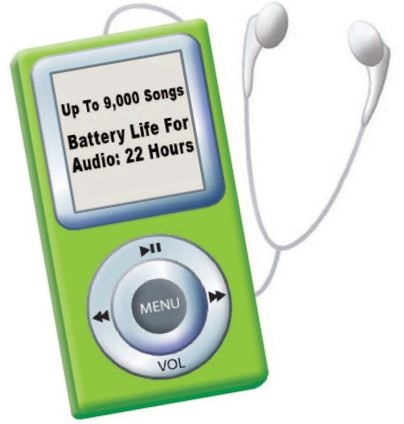
Answer: 1664.
Explanation: Total songs in portable media players are 9,000, And kylie has 832 songs. So Kylie can add 9000-832= 8,168 songs. Lance has 3 times as many songs as Kylie, So Lance has 832×3= 2,496. He can add 9000-2496= 6504 to his player. Therefore 8168-6504=1664 Lance can add 1664 fewer songs to his player than Kylie.
Question 20.
James wants to buy the new portable media player shown. He has 5 times as many songs as Susan. Susan has 1,146 songs. Will all of his songs fit on the portable media player? How many songs does James have?
Answer: 5,730 songs. Yes, will fit on the portable media player.
Explanation: Susan has 1,146 songs and James has 5 times as many songs as Susan, So 1,146 5= 5,730 songs will fit on the portable media player.
Question 21.
The sum of a 3-digit number and a 1-digit number is 217. The product of the numbers is 642. If one number is between 200 and 225, what are the numbers?
Answer: 3.
Explanation: As the given product is 642 and the 3 digit number is between 200 and 225, So the 1 digit number is 3 because if we multiply 200 and 225 by 3 we will get the product as 600 and 675 and 642 is in between them. So 642 3= 214. And the one-digit number is 3.
Question 22.
Mrs. Jackson bought 6 gallons of juice for a party. Each gallon has 16 cups. After the party, 3 cups of juice were left over. At the party, how many cups did people drink? Show your work and explain how you found your answer.
Answer: 93.
Explanation: Mrs. Jackson bought 6 gallons of juice and each gallon has 16 cups. So total cups of juice is 16 6= 96 cups. And in that 3 cups of juice was left after the party. So 96-3= 93 cups of juice people drank.
Common Core – Multiply Using Partial Products – Page No. 103
Estimate. Then record the product.
Question 1.
Estimate: 1,200
2 4 3
× 6
——————
1,200
2 4 0
+1 8
—————–
1,458
Question 2.
6 4 0
× 3
——————
Estimate: _________
Product: _________
Answer:
Estimate: 1800
Product: 1920.
Explanation: Rounding off 640 to 600 then estimated product is 600 3= 1800 and 640 3= 1920.
6 4 0
× 3
——————
1800
+120
+0
——————
1920
Question 3.
$ 1 4 9
× 5
——————
Estimate: $ _________
Product: $ _________
Answer:
Estimate: $500
Product: $745
Explanation: Rounding off 149 to 100 then estimated product is 100 5= 500 and 149 5= 745.
$ 1 4 9
× 5
——————
500
+200
+45
——————
745
Question 4.
7 2 1
× 8
——————
Estimate: _________
Product: _________
Answer:
Estimate: 5600
Product: 5768
Explanation: Rounding off 721 to 700 then estimated product is 700 8= 5600 and 721 8= 5,768.
7 2 1
× 8
——————
5600
+160
+8
——————
5,768
Question 5.
2 9 3
× 4
——————
Estimate: _________
Product: _________
Answer:
Estimate: 1,200
Product: 1,172
Explanation: Rounding off 293 to 300 then estimated product is 300 4= 1200 and 293 4=1,172.
2 9 3
× 4
——————
800
+360
+12
——————
1,172
Question 6.
$ 4 1 6
× 6
——————
Estimate: $ _________
Product: $ _________
Answer:
Estimate: $2400
Product: $2496
Explanation: Rounding off 293 to 300 then estimated product is 400 6= 2400 and
416 6= 2496.
$ 4 1 6
× 6
——————
2400
+60
+36
—————–
2,496
Question 7.
9 6 1
× 2
——————
Estimate: _________
Product: _________
Answer:
Estimate: 2000
Product: 1922
Explanation: Rounding off 961 to 1000 then estimated product is 1000 2= 2000 and
961 2= 1922.
9 6 1
× 2
——————
1800
+120
+2
——————-
1922
Question 8.
8 3 7
× 9
——————
Estimate: _________
Product: _________
Answer:
Estimate: 7,200
Product: 7,533
Explanation: Rounding off 837 to 800 then estimated product is 800 9= 7200 and
837 9= 7533.
8 3 7
× 9
——————
7200
+270
+63
—————–
7533
Question 9.
6 5 2
× 4
——————
Estimate: _________
Product: _________
Answer:
Estimate: 2,800
Product: 2,608
Explanation: Rounding off 652 to 700 then estimated product is 700 4= 2800 and
652 4= 2,608.
6 5 2
× 4
——————
2400
+200
+8
—————–
2608
Question 10.
3 0 7
× 3
——————
Estimate: _________
Product: _________
Answer:
Estimate: 900
Product: 921
Explanation: : Rounding off 307 to 300 then estimated product is 300 3= 900 and
307 3= 921.
3 0 7
× 3
——–
900
+21
——
921
Question 11.
5 4 3
× 7
——————
Estimate: _________
Product: _________
Answer:
Estimate: 3500
Product: 3,801
Explanation: : Rounding off 543 to 500 then estimated product is 500 7= 3500 and
543 7= 3801.
5 4 3
× 7
——————
3500
+280
+21
—————–
3801
Question 12.
$ 8 2 2
× 5
——————
Estimate: $ _________
Product: $ _________
Answer:
Estimate: $4,000.
Product: $4,110.
Explanation: Explanation: : Rounding off 822 to 800 then estimated product is 800 5= 4000 and
822 5= 4110.
$ 8 2 2
× 5
——————
4000
+100
+10
——————
4110
Problem Solving
Question 13.
A maze at a county fair is made from 275 bales of hay. The maze at the state fair is made from 4 times as many bales of hay. How many bales of hay are used for the maze at the state fair?
Answer: 1100 bales.
Explanation: No. of country fair bales are 275 and state fair bales are 4 times as many as country fair bales. So 275 4= 1100
Question 14.
Pedro gets 8 hours of sleep each night. How many hours does Pedro sleep in a year with 365 days?
Answer: 2,920 hours.
Explanation: Pedro sleeps 8 hours each night and 365 days Pedro sleeps 365 8= 2,920 hours.
Common Core – Multiply Using Partial Products – Lesson Check – Page No. 104
Question 1.
A passenger jet flies at an average speed of 548 miles per hour. At that speed, how many miles does the plane travel in 4 hours?
Options:
a. 2,092 miles
b. 2,112 miles
c. 2,192 miles
d. 2,480 miles
Answer: c
Explanation: Average speed of passenger jet is 548 miles per hour. And the plane travels in 4 hours is 548 4= 2,192 miles.
Question 2.
Use the model to find 3 x 157.
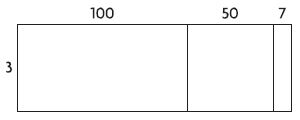
Options:
a. 300,171
b. 300,157
c. 471
d. 451
Answer: c.
Explanation: By distributive property of multiplication 3 x 157= 3 x(100+50+7)
=(3 x100)+(3×50)+(3×7)
=300+150+21
=471
Spiral Review
Question 3.
The school fun fair made $1,768 on games and $978 on food sales. How much money did the fun fair make on games and food sales?
Options:
a. $2,636
b. $2,646
c. $2,736
d. $2,746
Answer: $2746.
Explanation: Money made on games is $1,768 and on food sale is $978. So total money make on games and food sales are 1768+978= 2746.
Question 4.
Use the table below.
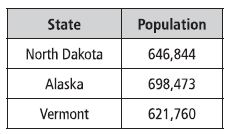
Which of the following lists the states from least to greatest population?
Options:
a. Alaska, North Dakota, Vermont
b. Vermont, Alaska, North Dakota
c. North Dakota, Vermont, Alaska
d. Vermont, North Dakota, Alaska
Answer: d.
Explanation: Vermont has 621,760, North Dakota has 646,844 and Alaska has 698,473.
So Vermont, North Dakota, Alaska.
Question 5.
A National Park covers 218,375 acres. What is this number written in expanded form?
Options:
a. 200,000 + 10,000 + 8,000 + 300 + 70 + 5
b. 20,000 + 1,000 + 800 + 30 + 75
c. 218 + 375
d. 218 thousand, 375
Answer: a.
Explanation: 218,375 is expanded as 200,000 + 10,000 + 8,000 + 300 + 70 + 5
Question 6.
Last year a business had profits of $8,000. This year its profits are 5 times as great. What are this year’s profits?
Options:
a. $4,000
b. $40,000
c. $44,000
d. $400,000
Answer: b
Explanation: Last year’s profit of $8,000 and this year 5 times more. So this year profit is 8000 5= 40,000.
Multiply Using Partial Products – Page No. 105
Choose the best term from the box to complete the sentence.

Question 1.
To find the product of a two-digit number and a 1-digit number, you can multiply the tens, multiply the ones, and find the sum of each ________________.
Answer: Factor
Explanation: Factors are the numbers which divides the original number completely.
Question 2.
The _____________ states that multiplying a sum by a number is the same as multiplying each addend by the number and then adding the products.
Answer: Distributive Property
Explanation: Distributive property means if we multiply a sum by a number is the same as multiplying each addend by the number and adding the products.
Write a comparison sentence.
Question 3.
5 × 9 = 45
______ times as many as ______ is ______ .
Answer: 5 times as many as 9 is 45
Explanation:

Question 4.
24 = 6 × 4
______ is ______ times as many as ______ .
Answer: 24 is 6 times as many as 4.
Explanation:

Question 5.
54 = 6 × 9
______ is ______ times as many as ______ .
Answer: 54 is 6 times as many as 9
Explanation:

Question 6.
8 × 6 = 48
______ times as many as ______ is ______ .
Answer: 48 is 8 times as many as 6.
Explanation:

Estimate. Then record the product.
Question 7.
7 5
× 5
—————
Estimate: ________
Product: ________
Answer:
Estimate: 500
Product: 375
Explanation: Rounding off 75 to 100 estimated value is 100×5= 500 and 75×5= 375
Question 8.
1 2
× 6
—————
Estimate: ________
Product: ________
Answer:
Estimate: 60
Product: 72
Explanation: Rounding off 12 to 10 estimated value is 10×6= 60 and 12×6= 72
Question 9.
2 8
× 3
—————
Answer:
Estimate: 90
Product: 84
Explanation: Rounding off 28 to 30 estimated value is 30×3= 90 and 28×3= 84
Question 10.
$4 3
× 6
—————
Estimate: $ ________
Product: $ ________
Answer:
Estimate: 300
Product: 258
Explanation: Rounding off 43 to 50 estimated value is 50×6= 300 and 43×6= 258
Record the product. Use expanded form to help.
Question 11.
5 × 64 = _____
Answer: 320
Explanation: 5 × 64= 5×(60+4)
=(5×60)+(5×4)
=300+20
=320
Question 12.
3 × 272 = _____
Answer: 812
Explanation: 3 × 272= 3×(200+70+2)
=(3×200)+(3×70)+(3×2)
=600+210+6
= 812
Multiply Using Partial Products – Page No. 106
Question 13.
There are 6 times as many dogs as cats. If the total number of dogs and cats is 21, how many dogs are there?
Answer: 18 dogs.
Explanation: Let cats be X and dogs are as many as 6 so dogs be 6X. As the total number of cats and dogs are X+6X=21, And X= 3 so dogs are 6×3= 18
Question 14.
The table below shows the number of calories in 1 cup of different kinds of berries. How many calories are in 4 cups of blackberries?

Answer: 248 Calories.
Explanation: The number of calories of blackberries in one cup are 62 and in 4 cups are 62×4= 248.
Question 15.
The skating rink rented 218 pairs of skates during the month of April and 3 times that many in May. How many pairs of skates did the skating rink rent during April and May?
Answer: 872 pairs.
Explanation: No. of pairs of skates in April are 218 and 3 times that many in May. So
3×218= 654. Total skates in April and May are 218+654= 872
Multiply Using Partial Products – Page No. 109
Question 1.
Break apart the factor 112 to find 7 × 112 by using mental math and addition.
7 × 112 = 7 × (_____ + 12)
Answer: 100
Explanation: 7 × 112 = 7 × (100 + 12)
= 7×(100+12)
= 700+84
= 784
Find the product. Tell which strategy you used.
Question 2.
4 × 6 × 50 = _____
Answer: 1200, Associative property.
Explanation:
4 × 6 × 50= 4 ×(6×50)
=4×(300)
=1200.
Question 3.
5 × 420 = _____
Answer: 2100, Use addition
Explanation: 420= 400+20
5×420= 5×(400+20)
=(5×400)+(5×20)
=2000+100
=2100.
Question 4.
6 × 298 = _____
Answer: 1788, Distributive property.
Explanation: 6×298 = 6×(200+90+8)
= (6×200)+( 6×90)+( 6×8)
= 1200+540+48
= 1788
Find the product. Tell which strategy you used.
Question 5.
14 × 50 = _____
Answer: 700, Halving and doubling.
Explanation: 14×50= (14×25)+(7×50)
= 350+350
= 700
Question 6.
32 × 25 = _____
Explanation: 32 × 25= 32× (20+5)
=(32×20)+(32×5)
=640+160
=800
Question 7.
8 × 25 × 23 = _____
Answer: 4,600, Associative property.
Explanation: 8×25×23=(8×25)× 23
=(200) ×23
4,600
Practice: Copy and Solve Use a strategy to find the product.
Question 8.
16 × 400 = _____
Answer: 6400, Distributive Property.
Explanation: 16×400= (8+8)×400
=(8×400)+ (8×400)
=3200+3200
=6400
Question 9.
3 × 31 × 10 = _____
Answer: 930, Associative property.
Explanation: 3×31×10= (3×31)×10
=(93) ×10
=930
Question 10.
3 × 199 = _____
Answer: 597, Distributive property.
Explanation: 3×199=3×(100+90+9)
=(3×100)+(3×90)+(3×9)
=300+270+27
= 597
Question 11.
3 × 1,021 = _____
Answer: 3063, Distributive Property.
Explanation: 3×1021= 3×(1000+20+1)
=(3×1000)+(3×20)+(3×1)
=3000+60+3
=3063
Identify Relationships Algebra Use mental math to find the unknown number.
Question 12.
21 × 40 = 840, so
21 × 42 = _____
Answer: 882
Explanation: By Distributive property 21 × 42= 21(40+2)
=(21×40)+(21×2)
=840+42
=882
Question 13.
9 × 60 = 540, so
18 × 30 = _____
Answer: 540
Explanation: As one factor is halved and the other one is doubled and the result is an equivalent expression.
Question 14.
The science museum sells dinosaur models to schools and libraries for $107 each. The town library buys 3 models. The town elementary school buys 5 models. What is the total cost of the models the town buys?
Answer: $856.
Explanation: The cost of each dinosaur model is $107, And the town library buys 3 models which cost 107×3= 321, and town elementary school buys 5 models which cost 107×5= 535. Total cost is 321+535= 856.
Question 15.
Kyle and Karen each bought 6 books of ride tickets at the fair. Each book has 15 tickets. How many tickets did they buy altogether?
Answer: 180 tickets
Explanation: Kyle and Karen each bought 6 books each that means total of 12 books and each book has 15 tickets. So total tickets both bought are 12×15= 180
Multiply Using Partial Products – Page No. 110
Use the table for 16–18.
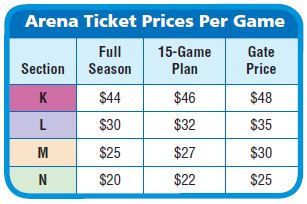
Question 16.
Three thousand, forty-three people buy tickets at the gate for Section N and one hundred people buy tickets at the gate for Section L. How much money is collected for Section N and Section L at the gate?
Answer: $79575.
Explanation: As 3043 people bought tickets at the gate for Section N, So 3043×25= $76075 and 100 people bought tickets at the gate for Section L, So 100×35= $3500. The total money collected by both sections is 76075+3500= 79575.
Question 17.
Use Diagrams Tina and 3 of her friends buy the full season plan for Section M. If there are 45 games in the full season, how much money do they spend?
Answer: $4500.
Explanation: Tina and 3 of her friends which means a total of 4 members bought full season for Section M which costs $25 for each, So total cost is 25×4= 100. If there are 45 games in full seasons then 45×100= $4500.
Question 18.
When the full season tickets first went on sale, 2,000 Full Season tickets sold for Section N. Two weeks after the tickets first went on sale, another 1,500 full season tickets were sold for Section N. How much money was spent on full season tickets for Section N in total? How much more money was spent when the tickets first went on sale than after the first two weeks?
$ _____ was spent on full season tickets for Section N in total;
Answer: $70,000. $10,000 more
Explanation: The first sale tickets sold are 2,000 for Section N which is 2,000×20= 40,000.
And in next sale 1500 tickets sold out which is 1500×20= 30,000. Total money spent are 40,000+30,000= 70,000.
Question 19.
Find 6 × 407. Show your work and explain why the strategy you chose works best with the factors.
Answer: 2,442
Explanation: By using Distributive property 6×407= 6×(400+7)
=(6×400)+(6×7)
=2400+42
=2,442.
Common Core – Multiply Using Mental Math – Page No. 111
Find the product. Tell which strategy you used.
Question 1.
6 × 297
Think: 297 = 300 – 3
6 × 297 = 6 × (300 – 3)
= (6 × 300) – (6 × 3)
= 1,800 – 18
= 1,782;
use subtraction
Question 2.
8 × 25 × 23 = _____
Answer: 4,600. Associative property.
Explanation: Associative property states that the terms in an addition or multiplication problem can be grouped in different ways, and the answer remains the same.
8 × 25 × 23= (8×25)×23
=200×23
=4600
Question 3.
8 × 604 = _____
Answer: 4832, Use Addition.
Explanation: 604= 600+4
8×604= 8×(600+4)
=(8×600)+(8×4)
=4800+32
=4832.
Question 4.
50 × 28 = _____
Answer: 1400, Halving and doubling.
Explanation: 50×28= (25×28)+(50×14)
=700+700
=1400
Question 5.
9 × 199 = _____
Answer: 1,791
Explanation: By Distributive property 9 × 199= 9 ×(100+90+9)
=(9×100)+(9×90)+(9×9)
=900+810+81
= 1791
Question 6.
20 × 72 × 5 = _____
Answer: 7,200.
Explanation: Associative property states that the terms in an addition or multiplication problem can be grouped in different ways, and the answer remains the same.
20 × 72 × 5= (20×72) ×5
=1440×5
=7,200.
Question 7.
32 × 25 = _____
Answer: 800.
Explanation: Multiplication.
32×25= 800.
Problem Solving
Question 8.
Section J in an arena has 20 rows. Each row has 15 seats. All tickets cost $18 each. If all the seats are sold, how much money will the arena collect for Section J?
Answer: $5400.
Explanation: Total rows in the arena are 20 rows and each row has 15 seats. So total seats are 20×15= 300 seats. And each ticket cost is $18, So the total ticket price is 300×15= 5400.
Question 9.
At a high-school gym, the bleachers are divided into 6 equal sections. Each section can seat 395 people. How many people can be seated in the gym?
Answer: 2,370 people.
Explanation: Total sections are 6 and each section contains 395 people. So total members can be seated in the gym are 395×6= 2,370 people.
Common Core – Multiply Using Mental Math – Lesson Check – Page No. 112
Question 1.
Pencils come in cartons of 24 boxes. A school bought 50 cartons of pencils for the start of school. Each box of pencils cost $2. How much did the school spend
on pencils?
Options:
a. $240
b. $1,200
c. $2,400
d. $4,800
Answer: c
Explanation: Total boxes of pencils are 24 and a school bought 50 cartons of pencils. So total no. of boxes are 24×50=1200 and each box of pencils cost $2. So 1200×2= 2400 school has spent.
Question 2.
The school also bought 195 packages of markers. There are 6 markers in a package. How many markers did the school buy?
Options:
a. 1,170
b. 1,195
c. 1,200
d. 1,230
Answer: a
Explanation: The school bought 195 packages of markers and each package contains 6 markers, So total markers are 195×6= 1170
Spiral Review
Question 3.
Alex has 175 baseball cards. Rodney has 3 times as many baseball cards as Alex. How many fewer cards does Alex have than Rodney?
Options:
a. 700
b. 525
c. 450
d. 350
Answer: d
Explanation: Alex has 175 baseball cards and Rodney has 3 times as many as Alex, So total no. of cards Rodney have are 175×3= 525. And Alex has 525-175= 350 fewer cards than Rodney.
Question 4.
A theater seats 1,860 people. The last 6 shows have been sold out. Which is the best estimate of the total number of people attending the last 6 shows?
Options:
a. fewer than 6,000
b. about 6,000
c. fewer than 12,000
d. more than 20,000
Answer: c
Explanation: No. of seats in a theater are 1,860 people and last 6 shows have been sold out, So 1,860×6= 11,160 which are fewer than 12,000.
Question 5.
At one basketball game, there were 1,207 people watching. At the next game, there were 958 people. How many people in all were at the two games?
Options:
a. 2,155
b. 2,165
c. 2,265
d. 10,787
Answer: b
Explanation: There are 1207 people are watching basketball game and in the next game 958 people are there. So total no. of people are 1,207+958= 2165.
Question 6.
Bill bought 4 jigsaw puzzles. Each puzzle has 500 pieces. How many pieces are in all the puzzles altogether?
Options:
a. 200
b. 900
c. 2,000
d. 20,000
Answer: c
Explanation: Bill bought 4 jigsaw puzzle and each puzzle has 500 pieces. So altogether pieces are 500×4= 2000.
Multiply Using Mental Math – Page No. 115
Question 1.
The seats in Sections A and B of the stadium are all taken for the last show. Section A has 8 rows of 14 seats each. Section B has 6 rows of 16 seats each. How many people are seated in Sections A and B for the last show?
First, draw and label a diagram. Next, find the number of seats in each section.
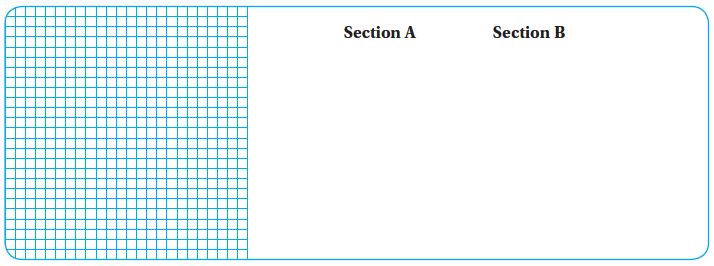
Last, find the total number of seats.
_____ + _____ = _____
Answer: 112+96= 208.
Explanation: As section A has 8 rows and 14 seats each, So 14×8= 112 and Section B has 6 rows and 16 seats each, So 16×6= 96. Total no. of people are seated in Section A and Section B are
112+96= 208.
Question 1.
There are _____________ people seated in Sections A and B for the last show.
Answer: 208.
Explanation: As Section A has 112 people and Section B has 96 people, So 112+96= 208.
Question 2.
What if Sections A and B each had 7 rows? How many people would have been seated in Sections A and B?
Answer: 210
Explanation: As section A has 7 rows and 14 seats each, So 14×7= 98 and Section B has 7 rows and 16 seats each, So 16×7= 112. Total no. of people are seated in Section A and Section B are
112+98= 210.
Question 3.
Brenda’s vegetable garden has 13 rows with 8 plants in each row. Brenda plans to plant peppers in the first 2 rows and the last 2 rows of the garden. The rest of the rows will be tomatoes. How many tomato plants will Brenda plant?
Answer: 72 tomato plants
Explanation: Brenda’s vegetable garden has 13 rows with 8 plants in each row as she plans to plant first 2 rows and last 2 rows with pepper, So 13-4= 9 rows contains tomato plants and each row contains 8 plants, So 9×8= 72 tomato plants.
Question 4.
There are 8 rows of 22 chairs set up for an awards ceremony at the school. In each row, the 2 chairs on each end are reserved for students receiving awards. The rest of the chairs are for guests. How many chairs are there for guests?
Answer: 144 Chairs.
Explanation: As there are 8 rows with 22 chairs in each row, So total no. of chairs is 22×8= 176 chairs. As 2 chairs at each end are reserved for students receiving the award, So total chairs reserved are 8×4=32. So remaining chairs are 176-32= 144.
Multiply Using Mental Math – Page No. 116
Use the graph for 5–6.
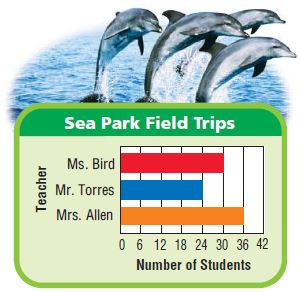
Question 5.
Mr. Torres took his students to the dolphin show. Each row in the stadium had 11 seats. One adult sat at each end of a row, and each group of 4 students was seated between 2 adults. Mr. Torres sat by himself. How many adults were there?
_____ adults including Mr. Torres
Answer: 13 adults.
Explanation: First we must find total no. of rows, As there are 24 students each group contains 4 students, So 24 4= 6 rows. And one adult sat in each end of the row, So in 6 rows 2 people will sit. Therefore total adults are 6×2=12 adults+ Mr. Torres= 13 adults.
Question 6.
Another stadium section has 24 rows of 10 seats each. Describe at least two ways Mrs. Allen’s class can sit if an equal number of students sit in each row.
Answer: 9 rows of 4 students or 6 rows of 6 students.
Explanation: As there are 36 students in Mrs. Allen’s class. So students can sit in 6 rows of 6 students or 9 rows of 4 students.
Question 7.
Carol, Ann, and Liz each bought a toy fish. Carol’s fish is 10 inches longer than Ann’s fish. Liz’s fish is 2 inches longer than twice the length of Ann’s fish. Ann’s fish is 12 inches long. Find the length of each toy fish.
Carol’s: _____ in. Liz’s: _____ in.
Answer: Carol’s: 22 in., Liz’s: 26in.
Explanation: Ann’s fish is 12 inches longer and Carol’s fish is 10 inches longer than Ann’s fish which means 10+12= 22 inches, So Carol’s fish is 22 inches. Liz’s fish is 2 inches longer than twice the length of Ann’s fish, which means (2×12) +2=24+2= 26 inches.
Question 8.
Evaluate Relationships Nell made a secret code. Each code word has 2 letters. Each word begins with a consonant and ends with a vowel. How many code words can Nell make with 3 consonants and 2 vowels?
_____ code words
Answer: 6 ways.
Explanation: As each word begins with a consonant and ends with a vowel, So the first letter can be any one of 3 consonants and the second letter can be either one of 2 vowels. So Nell can make 3×2= 6 ways.
Question 9.
Allie is building a patio. The patio will have 8 tiles in each of 13 rows. She has already built the center section with 4 tiles in each of 7 rows. How many more tiles are needed to complete the patio? Show your work.
Answer: 76 tiles.
Explanation: Allie had 8 tiles in each of 13 rows, which means 13×8= 104 tiles. And the center section was built by 4 tiles in each of 7 rows, which means 4×7= 28 tiles. So 104-28= 76 tiles more needed to complete the patio.
Common Core – Problem Solving Multistep Multiplication Problems – Page No. 117
Solve each problem.
Question 1.
A community park has 6 tables with a chessboard painted on top. Each board has 8 rows of 8 squares. When a game is set up, 4 rows of 8 squares on each board are covered with chess pieces. If a game is set up on each table, how many total squares are NOT covered by chess pieces?
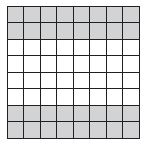
4 × 8 = 32
32 × 6 = 192 squares
Question 2.
Jonah and his friends go apple picking. Jonah fills 5 baskets. Each basket holds 15 apples. If 4 of Jonah’s friends pick the same amount as Jonah, how many apples do Jonah and his friends pick in all? Draw a diagram to solve the problem.
Answer: 375 apples.
Explanation: As Jonah fills 5 baskets which holds 15 apples, So Jonah picked 15×5= 75 apples.
And 4 of his friends pick same amount of apples, which means 75×4=300. So total apples Jonah and his friends picked up are 300+75= 375 apples.
Question 3.
There are 6 rows of 16 chairs set up for the third-grade play. In the first 4 rows, 2 chairs on each end are reserved for teachers. The rest of the chairs are for students. How many chairs are there for students?
Answer: 80 chairs.
Explanation: As there are 6 rows of 16 chairs which means 16×6= 96 total chairs. And first 4 rows 2 chairs on each end are reserved for teachers, which means 4×4= 16 chairs are reserved for teachers. So 96-16= 80 chairs are left for the students.
Common Core – Problem Solving Multistep Multiplication Problems – Lesson Check – Page No. 118
Question 1.
At a tree farm, there are 9 rows of 36 spruce trees. In each row, 14 of the spruce trees are blue spruce. How many spruce trees are NOT blue spruce?
Options:
a. 126
b. 198
c. 310
d. 324
Answer: b
Explanation: There are 9 rows of 36 spruce trees which means 9×36= 324 spruce trees. And in that, each row has 14 blue spruce trees which mean 14×9= 126. So 324-126= 198 spruce trees are not blue.
Question 2.
Ron is tiling a countertop. He needs to place 54 square tiles in each of 8 rows to cover the counter. He wants to randomly place 8 groups of 4 blue tiles each and have the rest of the tiles be white. How many white tiles will Ron need?
Options:
a. 464
b. 432
c. 400
d. 32
Answer: c
Explanation: Ron places 54 square tiles in each of 8 rows which means 54×8=432 tiles. And he randomly places 8 groups of 4 blue tiles which means 8×4= 32 blue tiles are placed. So no. of white tiles are 432-32= 400.
Question 3.
Juan reads a book with 368 pages. Savannah reads a book with 172 fewer pages than Juan’s book. How many pages are in the book Savannah reads?
Options:
a. 196
b. 216
c. 296
d. 540
Answer: a
Explanation: Juan reads a book with 368 pages and Savannah reads a book with 172 fewer pages than Juan’s which means 368-172= 196 pages are in Savannah’s read.
Question 4.
Hailey has bottles that hold 678 pennies each. About how many pennies does she have if she has 6 bottles filled with pennies?
Options:
a. 3,600
b. 3,900
c. 4,200
d. 6,000
Answer: c
Explanation: Let’s round off 678 to 700 and Hailey has bottles that hold 700 pennies each and if she has 6 bottles filled with pennies which means 700×6= 4200.
Question 5.
Terrence plants a garden that has 8 rows of flowers, with 28 flowers in each row. How many flowers did Terrence plant?
Options:
a. 1,664
b. 224
c. 164
d. 36
Answer: b
Explanation: As the garden has 8 rows of flowers with 28 flowers in each row, So no. of flowers is 28×8= 224.
Question 6.
Kevin has 5 fish in his fish tank. Jasmine has 4 times as many fish as Kevin has. How many fish does Jasmine have?
Options:
a. 15
b. 20
c. 25
d. 30
Answer: b
Explanation: As Kevin has 5 fishes and Jasmine has 4 times as many as Kevin which means 5×4= 20 fishes Jasmine has.
Problem Solving Multistep Multiplication Problems – Page No. 121
Question 1.
Use the model to find the product.
![]()
2 × 36 = _____
Answer: 72
Explanation: 2×36=2×(30+6)
=(2×30)+(2×6)
=60+12
=72
Estimate. Then record the product.
Question 2.
4 2
× 4
—————-
Estimate: _________
Product: _________
Answer:
Estimate: 160
Product: 168
Explanation: Round off 42 to 40 and estimated value is 40×4= 160 and 42×4= 168
4 2
× 4
——-
168
Question 3.
3 2
× 2
—————-
Estimate: _________
Product: _________
Answer:
Estimate: 60
Product: 64
Explanation: Round off 32 to 30 and the estimated value is 30×2= 60 and 32×2= 64.
3 2
× 2
——
64
Question 4.
8 1
× 5
—————-
Estimate: _________
Product: _________
Answer:
Estimate: 400
Product: 405
Explanation: Round off 81 to 80 and the estimated value is 80×5= 400 and 81×5= 405.
81
× 5
——
405
Question 5.
$6 3
× 7
—————-
Estimate: $ _________
Product: $ _________
Answer:
Estimate: 420
Product: 441
Explanation: Round off 63 to 60 and the estimated value is 60×7= 420 and 63×7= 441.
$63
× 7
——
441
Estimate. Then record the product.
Question 6.
3 3
× 2
—————-
Estimate: _________
Product: _________
Answer:
Estimate: 60
Product: 66
Explanation: Round off 33 to 30 and the estimated value is 30×2= 60 and 33×2= 66.
3 3
× 2
——
66
Question 7.
$2 5
× 3
—————-
Estimate: $ _________
Product: $ _________
Answer:
Estimate: 90
Product: 75
Explanation: Round off 25 to 30 and the estimated value is 30×3= 90 and 25×3= 75.
$25
× 3
——
75
Question 8.
3 6
× 8
—————-
Estimate: _________
Product: _________
Answer:
Estimate: 320
Product: 288
Explanation: Round off 36 to 40 and the estimated value is 40×8= 320 and 36×8= 288.
36
× 8
——
288
Question 9.
$9 4
× 5
—————-
Estimate: $ _________
Product: $ _________
Answer:
Estimate: 450
Product: 470
Explanation: Round off 94 to 90 and the estimated value is 90×5= 450 and 94×5= 470.
$94
× 5
——
470
Practice: Copy and Solve Estimate. Then record the product.
Question 10.
3 × 82
Estimate: _________
Product: _________
Answer:
Estimate: 240
Product: 246
Explanation: Round off 82 to 80 and the estimated value is 80×3= 240 and 82×3= 246.
3 2
× 2
——
246
Question 11.
9 × 41
Estimate: _________
Product: _________
Answer:
Estimate: 360
Product: 369
Explanation: Round off 41 to 40 and the estimated value is 40×9= 360 and 41×9= 369.
41
×9
——
369
Question 12.
7 × $23
Estimate: $ _________
Product: $ _________
Answer:
Estimate: 140
Product: 161
Explanation: Round off 23 to 20 and the estimated value is 20×7= 140 and 23×7= 161.
23
× 7
——
161
Question 13.
8 × $54
Estimate: $ _________
Product: $ _________
Answer:
Estimate: 400
Product: 432
Explanation: Round off 54 to 50 and the estimated value is 50×8= 400 and 54×8= 432.
54
×8
——
432
Identify Relationships Algebra Write a rule. Find the unknown numbers.
Question 15.

Answer: 36, 60
Explanation: If 1 carton contains 12 eggs then 3 cartons will have 3×12= 36 and 5 cartons contains 5×12= 60.
Question 16.

Answer: 160, 192
Explanation: If 2 rows have 32 seats then 5 rows will have 5×32= 160 and 6 rows will have 6×32= 192 seats
Question 17.
It will cost $73 per hour to rent a sailboat and $88 per hour to rent a ski boat. How much more will it cost to rent a ski boat than a sailboat for 4 hours?
Answer: $60.
Explanation: Cost of sailboat to rent per hour is $73 and for 4 hours it costs $73×4= $292. And cost of Ski boat to rent per hour is $88 and for 4 hours it costs $88×4= $352. So $352-$292= $60 much more costs for a ski boat than a sailboat.Problem Solving Multistep Multiplication Problems – Page No. 122
Use the table for 18–19.
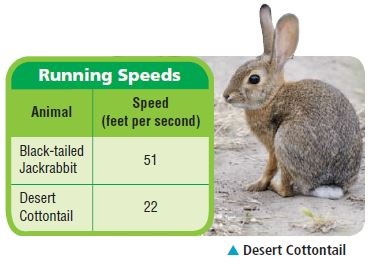
Question 18.
At the speeds shown, how much farther could a black-tailed jackrabbit run than a desert cottontail in 7 seconds?
Answer: 203 ft.
Explanation: Black-tailed jackrabbit runs at a speed of 51 ft per sec, So in 7 seconds jackrabbit runs 51×7= 357 ft and Desert cottontail runs at a speed of 22 ft per sec, So in 7 seconds it runs 22×7= 154 ft. So 357-154= 203 ft could a black-tailed jackrabbit run than a desert cottontail in 7 seconds.
Question 19.
A black-tailed jackrabbit hops about 7 feet in a single hop. How far can it hop in 5 seconds?
about ______ hops
Answer: 35 hops.
Explanation: As black-tailed jackrabbit hops about 7 feet in a single hop, So in 5 seconds it hops 7×5= 35.
Question 20.
Mr. Wright bought a 3-pound bag of cat food and a 5-pound bag of dog food. There are 16 ounces in each pound. How many ounces of pet food did Mr. Wright buy?
Answer: 128 ounces.
Explanation: Mr. Wright bought a 3-pound bag of cat food and there are 16 ounces in each pound, So 3×16= 48 ounces and 5pound bag of dog food as 5×16= 80 ounces. So total ounces of pet food are 48+80= 128 ounces.
Question 21.
The sum of two numbers is 31. The product of the two numbers is 150. What are the numbers?
Answer: 6 and 25.
Explanation: Let the numbers be X and Y, So the sum of two numbers is 31 which means X+Y=31 and product of two numbers is 150 which means X×Y=150. So X=31-Y then replace X=31-Y, So (31-Y)×Y= 150, then 31Y-Y^2 = 150 which is Y^2 – 31Y+ 150 = 0. By factorization Y= 25 and X×25= 150 then X= 6. Therefore X= 6 and Y= 25.
Question 22.
Use Reasoning 6 × 87 is greater than 5 × 87. How much greater? Explain how you know without multiplying.
Answer: 6×87>5 × 87.
Explanation: As 6 is greater than 5, So 6×87 is greater than 5 × 87
Question 23.
Multiply 6 × 73. For 23a–23d, select True or False for each statement.
a. A reasonable estimate of the product is $420.
i. True
ii. False
Answer: False
Explanation: 6×73= 438
Question 23.
b. Using partial products, the products are 42 and 180.
i. True
ii. False
Answer: False
Explanation: The partial products are 420 and 18
Question 23.
c. Using regrouping, 18 ones are regrouped as 8 tens and 1 one.
i. True
ii. False
Answer: False.
Explanation: 8 tens and 1 one means 81.
Question 23.
d. The product is 438.
i. True
ii. False
Answer: True
Explanation: 6×73= 438
Common Core – Multiply 2-Digit Numbers with Regrouping – Page No. 123
Estimate. Then record the product.
Question 1.
Estimate: 150
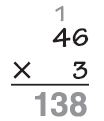
Question 2.
3 2
× 8
Estimate: ________
Product: ________
Answer:
Estimate: 240
Product: 256
Explanation: Round off 32 to 30 and 30×8=240.
3 2
× 8
————
256
Answer:
Estimate: 240
Product: 256
Explanation: Round off 32 to 30 and 30×8=240.
3 2
× 8
————
256
Answer:
Estimate: 240
Product: 256
Explanation: Round off 32 to 30 and 30×8=240.
3 2
× 8
————
256
Question 3.
$5 5
× 2
Estimate: $ ________
Product: $ ________
Answer:
Estimate: $120
Product: $110
Explanation: Round off 55 to 60 and 60×2= 120.
$5 5
× 2
————-
$110
Question 4.
6 1
× 8
Estimate: ________
Product: ________
Answer:
Estimate: 480
Product: 488
Explanation: Round off 61 to 60 and 60×8= 480.
6 1
× 8
———–
488
Question 5.
3 7
× 9
Estimate: ________
Product: ________
Answer:
Estimate: 360
Product: 333
Explanation: Round off 37 to 40 and 40×6= 360.
3 7
× 9
———–
333
Question 6.
$1 8
× 7
Estimate: $ ________
Product: $ ________
Answer:
Estimate: $140
Product: $126
Explanation: Round off 18 to 20 and 20×7= 140.
$1 8
× 7
———-
$126
Question 7.
8 3
× 5
Estimate: ________
Product: ________
Answer:
Estimate: 400
Product: 415
Explanation: Round off 83 to 80 and 80×5= 400.
8 3
× 5
——-
415
Question 8.
9 5
× 8
Estimate: ________
Product: ________
Answer:
Estimate: 800
Product: 760
Explanation: Round off 95 to 100 and 100×8= 800.
9 5
× 8
——–
760
Question 9.
9 4
× 9
Estimate: ________
Product: ________
Answer:
Estimate: 810
Product: 846
Explanation: Round off 94 to 90 and 90×9= 810.
9 4
× 9
——-
846
Question 10.
5 7
× 6
Estimate: ________
Product: ________
Answer:
Estimate: 360
Product: 342
Explanation: Round off 57 to 60 and 60×6= 360.
5 7
× 6
——
342
Question 11.
7 2
× 3
Estimate: ________
Product: ________
Answer:
Estimate: 210
Product: 216
Explanation: Round off 72 to 70 and 70×3= 210.
7 2
× 3
——-
216
Question 12.
$7 9
× 8
Estimate: ________
Product: ________
Answer:
Estimate: $640
Product: $632
Explanation: Round off 79 to 80 and 80×8= 640.
$7 9
× 8
——-
$632
Problem Solving
Question 13.
Sharon is 54 inches tall. A tree in her backyard is 5 times as tall as she is. The floor of her treehouse is at a height that is twice as tall as she is. What is the difference, in inches, between the top of the tree and the floor of the treehouse?
Answer: 162 inches.
Explanation: Sharon is 54 inches tall and a tree in her backyard is 5 times as tall as she is which means 54×5= 270. And her treehouse is twice as tall as she is which means 54×2= 108 inches. So the difference between the top of the tree and the floor of the treehouse is 270-108= 162 inches.
Question 14.
Mr. Diaz’s class is taking a field trip to the science museum. There are 23 students in the class, and a student admission ticket is $8. How much will the student
tickets cost?
Answer: $184.
Explanation: Total no. of students are 23 and tickets cost is $8, So 23×8= $184.
Common Core – Multiply 2-Digit Numbers with Regrouping – Lesson Check – Page No. 124
Question 1.
A ferryboat makes four trips to an island each day. The ferry can hold 88 people. If the ferry is full on each trip, how many passengers are carried by the ferry
each day?
Options:
a. 176
b. 322
c. 332
d. 352
Answer: d
Explanation: Total trips made by the ferryboat each day are 4 and it can hold 88 people, So 88×4= 352 passengers are carried by ferryboat each day.
Question 2.
Julian counted the number of times he drove across the Seven Mile Bridge while vacationing in the Florida Keys. He crossed the bridge 34 times. How many miles in all did Julian drive crossing the bridge?
Options:
a. 328 miles
b. 248 miles
c. 238 miles
d. 218 miles
Answer: c
Explanation: No. of times Julian drive across the bridge is 7 miles and he crossed the bridge 34 times, So 34×7= 238 miles Julian drive crossing the bridge.
Spiral Review
Question 3.
Sebastian wrote the population of his city as 300,000 + 40,000 + 60 + 7. Which of the following shows the population of Sebastian’s city written in standard form?
Options:
a. 346,700
b. 340,670
c. 340,607
d. 340,067
Answer: d
Explanation: 300,000+40,000+60+7= 340,067.
Question 4.
A plane flew 2,190 kilometers from Chicago to Flagstaff. Another plane flew 2,910 kilometers from Chicago to Oakland. How much farther did the plane that flew to Oakland fly than the plane that flew to Flagstaff?
Options:
a. 720 kilometers
b. 820 kilometers
c. 5,000 kilometers
d. 5,100 kilometers
Answer: a
Explanation: Plane flew from Chicago to Flagstaff is 2,190 km and another plane flew from Chicago to Oakland is 2,910, So 2910-2190= 720 km.
Question 5.
Tori buys 27 packages of miniature racing cars. Each package contains 5 cars. About how many miniature racing cars does Tori buy?
Options:
a. 15
b. 32
c. 100
d. 150
Answer: d
Explanation: Let’s round off 27 packages to 30 and each package contains 5 cars, which means 30×5=150.
Question 6.
Which of the following equations represents the Distributive Property?
Options:
a. 3 × 4 = 4 × 3
b. 9 × 0 = 0
c. 5 × (3 + 4) = (5 × 3) + (5 × 4)
d. 6 × (3 × 2) = (6 × 3) × 2
Answer: c
Explanation: Distributive property means if we multiply a sum by a number is the same as multiplying each addend by the number and adding the products.
Multiply 2-Digit Numbers with Regrouping – Page No. 127
Question 1.
Tell what is happening in Step 1 of the problem.
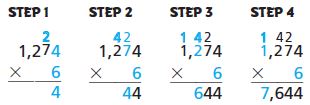
Answer: Multiplying 4×6
Explanation: In step 1 Multiplying 4×6= 24.
Estimate. Then find the product.
Question 2.
6 0 3
× 4
————
2,400
Estimate: __________
Product: ___________
Answer:
Estimate: 2400
Product: 2412
Explanation: Rounding off 603 to 600 then 600×4= 2400.
6 0 3
× 4
——–
2412
Question 3.
1,935
× 7
————
Estimate: __________
Product: ___________
Answer:
Estimate: 14,000.
Product: 13,545.
Explanation: Rounding off 1935 to 2000 then 2000×7= 14,000.
1,935
× 7
———
13,545
Question 4.
$ 8,326
× 5
————
Estimate: $ __________
Product: $ ___________
Answer:
Estimate: 40,000
Product: 41,630
Explanation: Rounding off 8326 to 8000 then 8000×5= 40,000.
$ 8,326
× 5
———-
41,630
Estimate. Then find the product.
Question 5.
$ 3,316
× 8
—————-
Estimate: $ __________
Product: $ ___________
Answer:
Estimate: 24,000.
Product: 26,528.
Explanation: Rounding off 3316 to 3000 then 3000×8= 24,000.
$ 3,316
× 8
———
26,528
Question 6.
$ 2,900
× 7
—————–
Estimate: $ __________
Product: $ ___________
Answer:
Estimate: 21,000.
Product: 20,300
Explanation: Rounding off 2900 to 3000 then 3000×7= 21,000.
$ 2,900
× 7
———-
20,300
Question 7.
$ 4,123
× 6
—————–
Estimate: $ __________
Product: $ ___________
Answer:
Estimate: 24,000.
Product: 24,738
Explanation: Rounding off 4,123 to 4000 then 4000×6= 24,000.
$ 4,123
× 6
———–
24,738
Question 8.
Mr. Jackson has $5,400 to buy supplies for the school computer lab. He buys 8 boxes of printer ink that cost $149 each and 3 printers that cost $1,017 each. How much money will Mr. Jackson have left after he buys the printer ink and printers?
Answer: $1,157
Explanation: As 8 boxes of printer ink cost $149 each which is $149×8=$1,192 and 3 printers costs $1,017 which is $1,017×3=$3,051. So 3051+1192= 4,243 total spent by Mr. Jackson on Printer ink and printers. The money left are $5,400-$4,243= 1,157.
Practice: Copy and Solve Compare. Write <, >, or = .
Question 9.
5 × 352 _____ 4 × 440
Answer: 5 × 352 = 4 × 440
Explanation: As 5 × 352= 1,760 and 4 × 440= 1,760
Question 10.
6 × 8,167 _____ 9,834 × 5
Answer: 6 × 8,167 < 9,834 × 5
Explanation: As 6 × 8,167= 49,002 and 9,834 × 5= 49,170. So 6 × 8,167 < 9,834 × 5
Question 11.
3,956 × 4 _____ 5 × 7,692
Answer: 3,956 × 4 < 5 × 7,692
Explanation: As 3,956 × 4= 15,824 and 5 × 7,692= 38,460. So 3,956 × 4 < 5 × 7,692
Question 12.
740 × 7 _____ 8 × 658
Answer: 740 × 7 < 8 × 658
Explanation: As 740 × 7 = 5180 and 8 × 658= 5264. So 740 × 7 < 8 × 658
Question 13.
4 × 3,645 _____ 5 × 2,834
Answer: 4 × 3,645 > 5 × 2,834
Explanation: As 4 × 3,645= 14580 and 5 × 2,834= 14,170. So 4 × 3,645 > 5 × 2,834.
Question 14.
6,573 × 2 _____ 4,365 × 3
Answer: 6,573 × 2 > 4,365 × 3
Explanation: As 6,573 ×2= 13,146 and 4,365 × 3= 13,095. So 6,573 × 2 > 4,365 × 3.
Multiply 2-Digit Numbers with Regrouping – Page No. 128
Question 15.
Airplane tickets to Fairbanks, Alaska, will cost $958 each. Airplane tickets to Vancouver, Canada, will cost $734. How much can the four members of the Harrison family save on airfare by vacationing in Vancouver?
Answer: $896.
Explanation: Airplane tickets cost for Alaska is $958 each. As Harrison family are 4 members so it will cost $958×4= $3,832 And for Vancouver it costs $734 each. So $734×4= $2,936 and Harrison family save $3832-$2936= $896.
Question 16.
Philadelphia, Pennsylvania, is 2,147 miles from Salt Lake City, Utah, and 2,868 miles from Portland, Oregon. What is the difference in the round-trip distances between Philadelphia and each of the other two cities? Explain whether you need an estimate or an exact answer.
Answer: 1,442 mi.
Explanation: The distance between Philadelphia and Salt Lake is 2,147 miles and round-trip distance is 2×2,147= 4,294 miles. And the distance between Philadelphia and Portland is 2,868 miles and the round-trip distance is 2×2868= 5736 miles. So the difference is
5,736-4,294= 1442 miles.
Question 17.
Verify the Reasoning of Others Joe says that the product of a 4-digit number and a 1-digit number is always a 4-digit number. Does Joe’s statement make sense? Explain.
Answer: No, Joe’s statement is incorrect.
Explanation: As there are regrouped thousands, the product of a 4-digit number and a 1-digit number can have 5 digits.
Question 18.
What number is 150 more than the product of 5 and 4,892? Explain how you found the answer.
Answer: 24,610.
Explanation: Let’s find the product of 5×4,892= 54,460 and then add 150 to the product, So 24,460+150= 24,610.
Common Core – Multiply 3-Digit and 4-Digit Numbers with Regrouping – Page No. 129
Estimate. Then find the product.
Question 1.
Estimate: 4,000
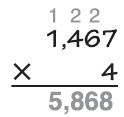
Question 2.
5,339
× 6
————-
Estimate: ________
Product: ________
Answer:
Estimate: 30,000
Product: 32,034
Explanation: Round off 5,339 to 5000 then 5000×6= 30,000.
5,339
× 6
———-
32,034
Question 3.
$879
× 8
————-
Estimate: $ ________
Product: $ ________
Answer:
Estimate: $7,200.
Product: $7,032.
Explanation: Round off 879 to 900 then 900×8= 7,200.
$879
× 8
——–
7,032
Question 4.
3,182
× 5
————-
Estimate: ________
Product: ________
Answer:
Estimate: 15,000
Product: 15,910
Explanation: Round off 3,182 to 3000 then 3000×5= 15,000.
3,182
× 5
———-
15,910
Question 5.
4,616
× 3
————-
Estimate: ________
Product: ________
Answer:
Estimate: 15,000
Product: 13,848
Explanation: Round off 4,616 to 5,000 then 5000×3= 15,000.
4,616
× 3
———
13,848
Question 6.
2,854
× 9
————-
Estimate: ________
Product: ________
Answer:
Estimate: 27,000
Product: 25,686
Explanation: Round off 2,854 to 3000 then 3000×9= 27,000.
2,854
× 9
———
25,686
Question 7.
7,500
× 2
————-
Estimate: ________
Product: ________
Answer:
Estimate: 16,000
Product: 15,000
Explanation: Round off 7,500 to 8000 then 8000×2= 16,000.
7,500
× 2
———
15,000
Question 8.
9 4 8
× 7
————-
Estimate: ________
Product: ________
Answer:
Estimate: 6,300
Product: 6,636
Explanation: Explanation: Round off 948 to 900 then 900×7= 6,300.
9 4 8
× 7
——-
6,636
Question 9.
1,752
× 6
————-
Estimate: ________
Product: ________
Answer:
Estimate: 12,000.
Product: 10,512.
Explanation: Explanation: Round off 1,752 to 2000 then 2000×6= 12,000.
1,752
× 6
———–
10,512
Question 10.
5 5 0
× 9
————-
Estimate: ________
Product: ________
Answer:
Estimate: 5,400
Product: 4,950
Explanation: Round off 550 to 600 then 600×9= 5,400.
5 5 0
× 9
——–
4,950
Question 11.
6,839
× 4
————-
Estimate: ________
Product: ________
Answer:
Estimate: 28,000
Product: 27,356
Explanation: Round off 6,839 to 7000 then 7000×4= 28,000.
6,839
× 4
———-
27,356
Question 12.
$9,614
× 6
————-
Estimate: $ ________
Product: $ ________
Answer:
Estimate: 60,000.
Product: 57,684.
Explanation: Round off 9,614 to 10,000 then 10,000×6= 60,000.
$9,614
× 6
———-
57,684
Problem Solving
Question 13.
Lafayette County has a population of 7,022 people. Columbia County’s population is 8 times as great as Lafayette County’s population. What is the population of Columbia County?
Answer: 56,176 people
Explanation: Lafayette County has a population of 7,022 people and Columbia County’s population is 8 times Lafayette County which means 7,022×8= 56,176.
Question 14.
A seafood company sold 9,125 pounds of fish last month. If 6 seafood companies sold the same amount of fish, how much fish did the 6 companies sell last month in all?
Answer: 54,750 pounds.
Explanation: As the seafood company sold 9,125 pounds of fishes last month and 6 seafood companies also sold the same amount which means 9,125×6= 54,750 pounds.
Common Core – Multiply 3-Digit and 4-Digit Numbers with Regrouping – Lesson Check – Page No. 130
Question 1.
By recycling 1 ton of paper, 6,953 gallons of water are saved. How many gallons of water are saved by recycling 4 tons of paper?
Options:
a. 24,602 gallons
b. 27,612 gallons
c. 27,812 gallons
d. 28,000 gallons
Answer: c
Explanation: As 1 ton of paper saves 6,953 gallons of water, So 4 tons of paper can save 6,953×4= 27,812.
Question 2.
Esteban counted the number of steps it took him to walk to school. He counted 1,138 steps. How many steps does he take walking to and from school each day?
Options:
a. 2,000
b. 2,266
c. 2,276
d. 22,616
Answer: c
Explanation: As Esteban counted 1,138 steps to school and from school, it will be 1,138+1,138=2,276 steps
Spiral Review
Question 3.
A website has 13,406 people registered. What is the word form of this number?
Options:
a. thirty thousand, four hundred six
b. thirteen thousand, four hundred sixty
c. thirteen thousand, four hundred six
d. thirteen thousand, six hundred six
Answer: c
Explanation: 13,406 in words are thirteen thousand four hundred six.
Question 4.
In one year, the McAlister family drove their car 15,680 miles. To the nearest thousand, how many miles did they drive their car that year?
Options:
a. 15,000 miles
b. 15,700 miles
c. 16,000 miles
d. 20,000 miles
Answer: c
Explanation: 15,680 nearest thousand is 16,000
Question 5.
Connor scored 14,370 points in a game. Amy scored 1,089 fewer points than Connor. How many points did Amy score?
Options:
a. 12,281
b. 13,281
c. 15,359
d. 15,459
Answer: b
Explanation: Connor scored 14,370 points and Amy scored 1,089 fewer points, So Amy score is 14,370-1089= 13,281.
Question 6.
Lea buys 6 model cars that each cost $15. She also buys 4 bottles of paint that each cost $11. How much does Lea spend in all on model cars and paint?
Options:
a. $134
b. $90
c. $44
d. $36
Answer: a
Explanation: Lea buys 6 model cars that each cost $15, So the total cost for cars is $15×6= $90.
And 4 bottles of paint that each cost $11, So the total cost of paints is $11×4= $44. Then
$90+$44= $134.
Multiply 3-Digit and 4-Digit Numbers with Regrouping – Page No. 133
Question 1.
Use the order of operations to find the value of n.
5 × 17 + 5 × 20 – 32 = n
n = ______
Answer: 153
Explanation: (5×17)+5×20 –32=
= 85+100-32
=185-32
=153
Find the value of n.
Question 2.
3 × 22 + 7 × 41 – 24 = n
n = ______
Answer: 329.
Explanation: 3×22+7×41–24
=66+287-24
=329.
Question 3.
4 × 34 + 6 × 40 – 66 = n
n = ______
Answer: 310.
Explanation: 4×34+6×40–66=
=136+240-66
=310.
Question 4.
2 × 62 + 8 × 22 – 53 = n
n = ______
Answer: 247
Explanation: 2×62+8×22–53=
= 124+176-53
=300-53
=247.
Question 5.
6 × 13 + 9 × 34 – 22 = n
n = ______
Answer: 362.
Explanation: 6×13+9×34–22=
=78+306-22
=384-22
=362.
Find the value of n.
Question 6.
8 × 42 + 3 × 59 – 62 = n
n = ______
Answer: 451.
Explanation: 8×42+3×59–62=
=336+177-62
=513-62
=451.
Question 7.
6 × 27 + 2 × 47 – 83 = n
n = ______
Answer: 173
Explanation: 6×27+2×47–83=
=162+94-83
=256-83
=173
Question 8.
Maggie has 3 binders with 25 stamps in each binder. She has 5 binders with 24 baseball cards in each binder. If she gives 35 stamps to a friend, how many stamps and cards does she have left?
Answer: 160
Explanation: Maggie has 3 binders with 25 stamps each binder, so total stamps are 3×25= 75. And 5 binders with 24 baseball cards in each binder. So total baseball cards are 24×5=120.
As she gave 35 stamps to a friend, so 75-35= 40. Total stamps and cards she has
120+40= 160
Question 9.
Evaluate Maddox has 4 boxes with 32 marbles in each box. He has 7 boxes with 18 shells in each box. If he gets 20 marbles from a friend, how many marbles and shells does he have?
Answer: 274.
Explanation: Maddox has 4 boxes and 32 marbles in each box, so 4×32= 128. And 7 boxes with 18 shells in each box which means 7×18= 126. And he got 20 marbles from a friend, so
128+20= 148 marbles. So total marbles and shells he has 148+126= 274.
Question 10.
The soccer team sells 54 bagels with cream cheese for $2 each and 36 muffins for $1 each during a bake sale. The coach uses the money to buy socks for the 14 players. The socks cost $6 per pair. How much money does the coach have left? Explain how you found your answer.
Answer: $60.
Explanation: Soccer team sells 54 bagels with cream cheese for $2 each, so 54×2= $108 total amount raised by selling bagels with cream cheese. And 36 muffins for $1 each which means 36×$1= $36 raised by selling muffins. So the total amount raised is $108+$36= $144. And he uses the money to buy socks for 14 players and each pair is $6, So 14×$6= $84 needed to buy socks for the players. So $144-$84= $60 left with the coach after buying socks for the players.
Multiply 3-Digit and 4-Digit Numbers with Regrouping – Page No. 134
Question 11.
What’s the Error? Dominic has 5 books with 12 postcards in each book. He has 4 boxes with 20 coins in each box. If he gives 15 post cards to a friend, how many postcards and coins does he have?
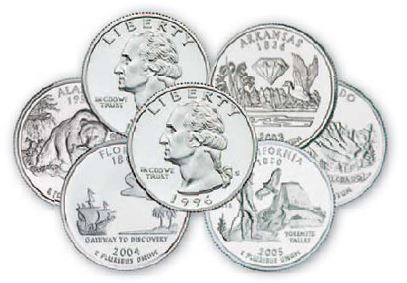
Dominic drew this model.

Dominic used these steps to solve.
5 × 12 + 4 × 20 – 15 = n
60 + 4 × 20 – 15 = n
64 × 20 – 15 = n
1,280 – 15 = n
1,265 = n
Look at the steps Dominic used to solve this problem. Find and describe his error.
Answer: Dominic didn’t follow the order of operations
Question 11.
Use the correct steps to solve the problem.
Answer:
5 × 12 + 4 × 20 – 15 = n
60+4×20-15=n
60+80-15=n
140-15=n
125=n
Common Core – Solve Multistep Problems Using Equations – Page No. 135
Find the value of n.
Question 1.
4 × 27 + 5 × 34 – 94 = n
108 + 5 × 34 – 94 = n
108 + 170 – 94 = n
278 – 94 = n
184 = n
Question 2.
7 × 38 + 3 × 45 – 56 = n
_____ = n
Answer: 345.
Explanation: 7×38+3×45-56=
=266+135-56
=401-56
=345
Question 3.
6 × 21 + 7 × 29 – 83 = n
_____ = n
Answer: 246
Explanation: 6×21+7×29-83=
=126+203-83
=329-83
=246
Question 4.
9 × 19 + 2 × 57 – 75 = n
_____ = n
Answer: 210.
Explanation: 9×19+2×57-75=
=171+114-75
=285-75
=210.
Question 5.
5 × 62 + 6 × 33 – 68 = n
_____ = n
Answer: 440.
Explanation: 5 × 62 + 6 × 33 – 68=
=310+198-68
=508-68
=440
Question 6.
8 × 19 + 4 × 49 – 39 = n
_____ = n
Answer: 309
Explanation: 8×19+4×49-39=
=152+196-39
=348-39
=309
Problem Solving
Question 7.
A bakery has 4 trays with 16 muffins on each tray. The bakery has 3 trays of cupcakes with 24 cupcakes on each tray. If 15 cupcakes are sold, how many muffins and cupcakes are left?
Answer: 121 muffins and cupcakes.
Explanation: 4×16+3×24-15=n
64+3×24-15=n
64+72-15=n
136-15=n
121=n
Question 8.
Katy bought 5 packages of stickers with 25 stickers in each package. She also bought 3 boxes of markers with 12 markers in each box. If she receives 8 stickers from a friend, how many stickers and markers does Katy have now?
Answer: 169 stickers and markers.
Explanation: 5×25+3×12+8=n
125+3×12+8=n
125+36+8=n
169=n
Common Core – Solve Multistep Problems Using Equations – Lesson Check – Page No. 136
Question 1.
What is the value of n?
9 × 23 + 3 × 39 – 28 = n
Options:
a. 240
b. 296
c. 2,310
d. 8,162
Answer: 296
Explanation: 9×23+3×39–28=
=207+117-28
=324-28
=296
Question 2.
Which expression has a value of 199?
Options:
a. 4 × 28 + 6 × 17 – 15
b. 4 × 17 + 6 × 28 – 38
c. 4 × 38 + 6 × 15 – 28
d. 4 × 15 + 6 × 38 – 88
Answer: a
Explanation: 4×28+6×17-15=
=112+102-15
=214-15
=199.
Spiral Review
Question 3.
Which expression shows how you can multiply 9 × 475 using expanded form and the Distributive Property?
Options:
a. (9 × 4) + (9 × 7) + (9 × 5)
b. (9 × 4) + (9 × 70) + (9 × 700)
c. (9 × 400) + (9 × 70) + (9 × 5)
d. (9 × 400) + (9 × 700) + (9 × 500)
Answer: c
Explanation: Distributive property means if we multiply a sum by a number is the same as multiplying each addend by the number and adding the products.
9 × 475= (9×400)+(9×70)+(9×5)
Question 4.
Which equation best represents the comparison sentence?
32 is 8 times as many as 4
Options:
a. 32 = 8 × 4
b. 32 × 8 = 4
c. 32 = 8 + 4
d. 8 + 4 = 32
Answer: a
Explanation: 32=8×4
Question 5.
Between which pair of numbers is the exact product of 379 and 8?
Options:
a. between 2,400 and 2,500
b. between 2,400 and 2,800
c. between 2,400 and 3,000
d. between 2,400 and 3,200
Answer: d
Explanation: 379×8= 3,032
Question 6.
Which of the following statements shows the halving and doubling strategy to find 28 × 50?
Options:
a. 28 × 50 = 14 × 100
b. 28 × 50 = (14 × 25) × (14 × 25)
c. 28 × 50 = (20 × 50) × (8 × 50)
d. 28 × 50 = 2 × (14 × 25)
Answer: a
Explanation: 28×50 = 14×100
Review/Test – Page No. 137
For 1–3, use the table.
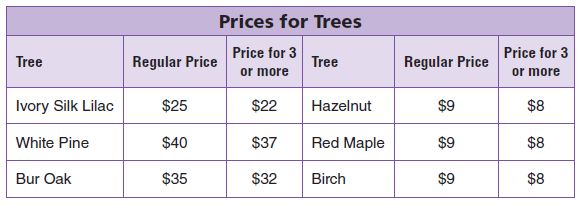
Question 1.
What is the cost of 3 Bur Oak trees? Show your work.
Answer: $96.
Explanation: Each Bur oak tree costs $32 for 3 and above, so $32×3=$96.
Question 2.
Mr. Tan buys 4 White Pine trees and 5 Birch trees. What is the cost of the trees? Show your work and explain how you found the answer.
Answer: $188.
Explanation: As 4 white pine trees cost is $37 each, so $37×4= $148 and 5 birch trees cost $8 each, so 5×$8= $40. Total cost of trees are $148+$40= $188.
Question 3.
Rudy will buy 3 Ivory Silk Lilac trees or 2 Bur Oak trees. He wants to buy the trees that cost less. What trees will he buy? How much will he save? Show your work.
Answer: Rudy will take 3 Ivory Silk Lilac trees which costs $66.
Explanation: If Rudy buys 3 Ivory Silk Lilac trees which costs $22 each, so $22×3=$66. And if 2 Bur Oak trees price is $35 each which means $35×2= $70. As Rudy wants to buy the trees that cost less, so he will take 3 Ivory Silk Lilac trees which cost $66.
Review/Test – Page No. 138
Question 4.
For numbers 4a–4d, select True or False for each equation.
a. 7 × 194 = 1,338
i. True
ii. False
Answer: False
Explanation: 7×194= 1,338.
Question 4.
b. 5 × 5,126 = 25,630
i. True
ii. False
Answer: True
Explanation: 5×5,126= 25,630.
Question 4.
c. 8 × 367 = 2,926
i. True
ii. False
Answer: False
Explanation: 8×367= 2,936
Question 4.
d. 4 × 3,952 = 15,808
i. True
ii. False
Answer: True
Explanation: 4×3952= 15,808
Question 5.
Part A
Draw a line to match each section in the model to the partial product it represents.
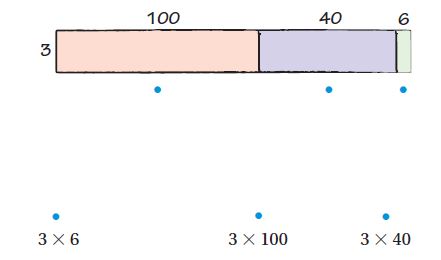
Question 5.
Part B
Then find 3 × 146. Show your work and explain.
Answer: 438.
Explanation: By distributive property
3×146= 3×(100+40+6)
=(3×100)+(3×40)+( 3×6)
=300+120+18
=438.
Review/Test – Page No. 139
Question 6.
For numbers 6a–6c, write an equation or a comparison sentence using the numbers on the tiles.
a.
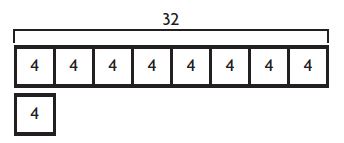
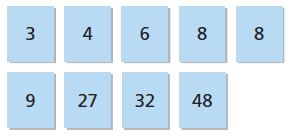
______ times as many as ______ is ______ .
Answer: 8 times as many as 4 is 32.
Explanation: 8×4= 32.
Question 6.
b.
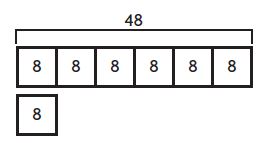
______ × ______ = ______
Answer: 6 times as many as 8 is 48.
Explanation: 6×8= 48.
Question 6.
c.
9 × 3 = 27
______ times as many as ______ is ______ .
Answer: 9 times as many as 3 is 27
Question 7.
Multiply 7 × 43. For 7a–7d, select True or False for each statement.
a. A reasonable estimate of the product is 280.
i. True
ii. False
Answer: True
Explanation: 7×43= 301. Take 43 and round off to 40 then 40×7= 280.
Question 7.
b. Using partial products, the products are 21 and 28.
i. True
ii. False
Answer: False
Explanation: 7×43= 7×(40+3)
=(7×40)+(7×3)
=280+21. So partial products are 280 and 21.
Question 7.
c. Using regrouping, 21 ones are regrouped as 1 ten and 2 ones.
i. True
ii. False
Answer: False.
Explanation: 1 ten and 2 ones is 12
Question 7.
d. The product is 301.
i. True
ii. False
Answer: True.
Explanation: 7×43= 7×(40+3)
=(7×40)+(7×3)
=280+21
=301.
Question 8.
It costs 9,328 points to build each apartment building in the computer game Big City Building. What is the cost to build 5 apartment buildings? Show your work.
Answer: 46,640 points.
Explanation: The cost of each building apartment is 9,328 points. To build 5 apartments its costs 9,3287×5= 46,640 points.
Review/Test – Page No. 140
Question 9.
Multiply 7 × 462 using place value and expanded form.
Choose the number from the box to complete the expression.
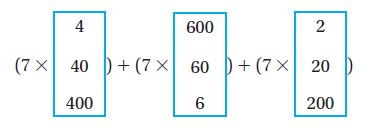
Answer: 400, 60, 2
Explanation: 7×462= 7×(400+60+2).
Question 10.
For numbers 10a–10b, use place value to find the product.
a.
3 × 600 = 3 × ______ hundreds
= ______ hundreds
______
Answer: 6 hundreds, 18 hundreds , 1800
Explanation: 3 × 600 = 3 × 6 hundreds
= 18 hundreds
= 1800.
Question 10.
b.
5 × 400 = 5 × ______ hundreds
______ hundreds
______
Answer: 4hundreds, 20hundreds, 2,000.
Explanation: 5 × 400 = 5 × 4hundreds
= 20 hundreds
= 2,000.
Question 11.
Liam has 3 boxes of baseball cards with 50 cards in each box. He also has 5 boxes with 40 basketball cards in each box. If Liam goes to the store and buys 50 more baseball cards, how many baseball and basketball cards does Liam have? Show your work.
Answer: Liam has 400 baseball and baseball cards.
Explanation: Liam has 3 boxes of baseball cards and there are 50 cards in each box, so total cards are 50×3= 150 baseball cards. And he has 5 boxes with 40 baseball cards in each box which means 5×40= 200. So total baseball cards are 150+200= 350. And he went to the store to buy 50 more baseball cards, so total baseball cards are 350+50= 400.
Review/Test – Page No. 141
Question 12.
There is a book sale at the library. The price for each book is $4. Which expression can be used to show how much money the library will make if it sells 289 books? Use the numbers on the tiles to complete your answer.
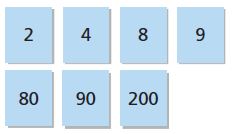
(4 × ______) + (4 × ______) + (4 × ______)
Answer: 200, 80, 9.
Explanation: As the price of each book is $4, so for 289 books it will be 4×289
= 4×(200+80+9)
=(4×200)+(4×80)+(4×9)
=800+320+36
=1,156.
Question 13.
Find 8 × 397. Show your work and explain why the strategy you chose works best with the factors.
Answer: 3,176.
Explanation: 8×397= 8×(300+90+7)
=(8×300)+(8×90)+(8×7)
=2400+720+56
=3,176.
Question 14.
A clown bought 6 bags of round balloons with 24 balloons in each bag. The clown also bought 3 bags of long balloons with 36 balloons in each bag.
Part A
How many more long balloons than round balloons did the clown buy? Show your work.
______ balloons
Answer: 36.
Explanation: As clown bought 6 bags of round balloons with 24 balloons in each bag, so
6×24= 144 and 3 bags of long balloons with 36 balloons in each bag, so 3×36= 108, So
144-108= 36.
Question 14.
Part B
The clown also bought 5 bags of heart-shaped balloons with 14 balloons in each bag. When the clown blew up all of the round, long, and heart-shaped balloons, 23 balloons burst. How many blown-up balloons were left? Explain your answer.
______ blown-up balloons
Answer: 299.
Explanation: The no. of heart-shaped balloons 5×14= 70. Then add that number to the number of round balloons and long balloons 70+144+108= 322 balloons in all. Then subtract the number of burst balloons, so 322-23= 299 balloons left.
Review/Test – Page No. 142
Question 15.
Hector planted 185 flowers in 2 days. There were 5 volunteers, including Hector, who each planted about the same number of flowers. About how many flowers did they plant?

Answer: 1000.
Explanation: Hector planted 185 flowers in 2 days, so 5 volunteers can plant 185×5= 925.
Question 16.
Jay and Blair went fishing. Together, they caught 27 fish. Jay caught 2 times as many fish as Blair. How many fish did Jay and Blair each catch? Write an equation and solve. Explain your work.
Jay: ______ fish; Blair: ______ fish
Answer: Blair caught 9 fishes and Jay caught 18 fishes.
Explanation: Blair caught n fish and Jay caught 2×n fish. Together they caught 3×n fish, so
3×n= 27 and n= 9 fishes, and 2×n= 18 fishes. Blair caught 9 fishes and Jay caught 18 fishes
Question 17.
At the pet fair, Darlene’s dog weighed 5 times as much as Leah’s dog. Together, the dogs weighed 84 pounds. How much did each dog weigh? Complete the bar model. Write an equation and solve.

Leah’s dog: ______ pounds; Darlene’s dog: ______ pounds;
Answer: Leah’s dog is 14 pound and Darlene’s dog weight is 70 pounds.
Explanation:
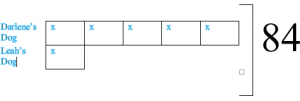
Let Leah’s dog weight be X and Darlene’s is 5 times as many as Leah’s, so Darlene’s dog weight be 5X. As together weight is 84 pounds, then X+5X= 84 and X= 14. So Leah’s dog weight is 14 and Darlene’s dog weight is 5×14= 70.
Question 18.
Use the Distributive Property to model the product on the grid.
Record the product.

4 × 12 = ______
Answer: 4×12= 48.
Explanation: 4×12=4×(10+2)
=(4×10)+(4×2)
=40+8
=48
Page No. 147
Question 1.
Find 20 × 27. Tell which method you chose. Explain what happens in each step.
Answer: 540
Explanation: It is mental maths. Because 2×27= 54 and 20×27= 540.
Choose a method. Then find the product.
Question 2.
10 × 12 = ______
Answer: 120
Explanation: Mental math, as 1×12=12 and 10×12= 120
Question 3.
20 × 20 = ______
Answer: 400
Explanation: Mental math, as 2×2=4 and 20×20= 400
Question 4.
40 × 24 = ______
Answer: 960
Explanation: Mental math, as 4×24=96 and 40×24= 960
Question 5.
11 × 60 = ______
Answer: 660
Explanation: Mental math, as 11×6=66 and 11×60= 660
Choose a method. Then find the product.
Question 6.
70 × 55 = ______
Answer: 3850
Explanation: Mental math, as 7×55=385 and 70×55= 3850
Question 7.
17 × 30 = ______
Answer: 510
Explanation: Mental math, as 17×3=51 and 17×30= 510
Question 8.
30 × 60 = ______
Answer: 1800
Explanation: Mental math, as 30×60=1800 and 30×60= 1800
Question 9.
12 × 90 = ______
Answer: 1080
Explanation: Mental math, as 12×9=108 and 12×90= 1080.
Reason Quantitatively Algebra Find the unknown digit in the number.
Question 10.
64 × 40 = 2,56■
■ = ______
Answer: 2,560
Explanation: Mental math, as 64×4=256 and 64×40= 510
Question 11.
29× 50 = 1,★50
★ = ______
Answer: 4
Explanation: Mental math, as 29×5=145 and 29×50= 1450
Question 12.
3⧫× 47 = 1,410
⧫ = ______
Answer: 0
Explanation: Mental math, as 3×47=1410 and 30×47= 1410
Question 13.
Caroline packs 12 jars of jam in a box. She has 40 boxes. She has 542 jars of jam. How many jars of jam will she have left when all the boxes are full?
Answer: 62 jars.
Explanation: Caroline packs 12 jars in a box and she has 40 boxes, so total boxes are
12×40= 480 boxes. As she has 542 jars of jam, so total jars left are 542-480= 62 jars.
Question 14.
Alison is preparing for a math contest. Each day, she works on multiplication problems for 20 minutes and division problems for 10 minutes. How many minutes does Alison practice multiplication and division problems in 15 days?
Answer: 450 mins.
Explanation: As Alison works on multiplication problems for 20 mins and 10 mins on division problems, So total time taken by Alison is 20+10=30 mins. So for 15 days Alison takes
15×30= 450 mins.
Page No. 148
Use the table for 15–16.
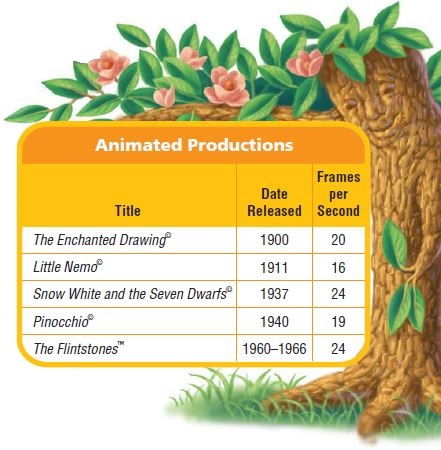
Question 15.
Use Graphs How many frames did it take to produce 50 seconds of Pinocchio?
Answer: 950 Frames.
Explanation: Total frames are 50×19= 950 frames.
Question 16.
Are there fewer frames in 10 seconds of The Flintstones or in 14 seconds of The Enchanted Drawing? What is the difference in the number of frames?
Answer: 40
Explanation: The Flintstone frames in 10 seconds are 10×24= 240 and The Enchanted Drawing frames are 14×20= 280. So the difference between them is 280-240= 40.
Question 17.
The product of my number and twice my number is 128. What is half my number? Explain how you solved the problem.
Answer: 4.
Explanation: First make a table to test numbers less than 10 since 10×20= 200, and 2×8= 16 then 8×16= 128 and 8÷2= 4.
Question 18.
Tanya says that the product of a multiple of ten and a multiple of ten will always have only one zero. Is she correct? Explain.
Answer: No.
Explanation: The product of two multiples of ten will always have at least 2 zeros.
Question 19.
For numbers 19a–19e, select Yes or No to tell whether the answer is correct.
a. 28 × 10 = 280
i. yes
ii. no
Answer: Yes
Question 19.
b. 15 × 20 = 300
i. yes
ii. no
Answer: Yes
Question 19.
c. 17 × 10 = 17
i. yes
ii. no
Answer: No
Question 19.
d. 80 × 10 = 800
i. yes
ii. no
Answer: Yes
Question 19.
e. 16 × 30 = 1,800
i. yes
ii. no
Answer: No
